Provenance, Age, and Tectonic Settings of Rock Complexes (Transangarian Yenisey Ridge, East Siberia): Geochemical and Geochronological Evidence
Abstract
:1. Introduction
2. Geological Background
2.1. Overview of the Regional Setting and Main Structural Elements of the Yenisey Ridge
2.2. Geology of the Studied Areas, Petrography, Textural Observations, and P–T Conditions of Metamorphism
2.2.1. Metabasite Tectonites
2.2.2. Granites
2.2.3. Basites
2.2.4. Mafic and Felsic Metavolcanites
2.2.5. Metapelites of the Garevka and Teya Complexes
3. Materials and Methods
3.1. Whole-Rock and Mineral Chemistry
3.2. Geothermobarometry
3.3. SHRIMP U-Pb Zircon Dating
3.4. U-Th-Pb Monazite and Zircon Ages
3.5. 40 Ar/39Ar Mica Dating
3.6. Sm-Nd Dating
4. Results
4.1. Major and Trace Element Geochemistry
4.1.1. Metabasite Tectonites
4.1.2. Granites of the Transangarian Yenisey Ridge
4.1.3. Basites of the Transangarian and Angara Parts of the Yenisey Ridge
4.1.4. Mafic and Felsic Metavolcanites
4.1.5. Metapelites of the GC and TC
4.2. Geochronological Data
4.2.1. Metabasite Tectonites
4.2.2. Granites
4.2.3. Basites
4.2.4. Mafic and Felsic Metavolcanites
4.2.5. Metapelites
5. Discussion
5.1. Tectonic Settings and Nature of Protolith
5.1.1. Metabasite Tectonites
5.1.2. Granitoids
5.1.3. Basites
5.1.4. Mafic and Felsic Metavolcanites
5.1.5. Metapelites of the GC and TC
5.2. Tectonic Implications
Age Correlations between Siberia–Laurentia–Baltica and Tectonic Interpretations
- Mesoproterozoic stage
- 2.
- Late Meso–Early Neoproterozoic stage
- 3.
- Middle- and late Neoproterozoic stage
Funding
Data Availability Statement
Acknowledgments
Conflicts of Interest
References
- Xiao, W.; Kusky, T.; Safonova, I.; Seltmann, R.; Sun, M. Tectonics of the Central Asian Orogenic Belt and its Pacific analogues. J. Asian Earth Sci. 2015, 113, 1–6. [Google Scholar] [CrossRef]
- Safonova, I. Juvenile versus recycled crust in the Central Asian Orogenic Belt: Implications from Ocean plate stratigraphy, blueschist belts and intra-Oceanic arcs. Gondwana Res. 2017, 47, 6–47. [Google Scholar] [CrossRef]
- Popov, N.V.; Likhanov, I.I.; Reverdatto, V.V.; Savko, K.A. Proterozoic granitoid magmatism at the southwestern margin of the Siberian platform in the tectonic history of the Angara-Kan block. Dokl. Earth Sci. 2020, 490, 81–86. [Google Scholar] [CrossRef]
- Likhanov, I.I.; Reverdatto, V.V. Geochemistry, petrogenesis, and age of metamorphic rocks of the Angara complex at the junction of South and North Yenisey Ridge. Geochem. Int. 2016, 54, 127–148. [Google Scholar] [CrossRef]
- Likhanov, I.I.; Santosh, M. Neoproterozoic intraplate magmatism along the western margin of the Siberian Craton: Implications for breakup of the Rodinia supercontinent. Precambrian Res. 2017, 300, 315–331. [Google Scholar] [CrossRef]
- Likhanov, I.I.; Santosh, M. A-type granites in the western margin of the Siberian Craton: Implications for breakup of the Precambrian supercontinents Columbia/Nuna and Rodinia. Precambrian Res. 2019, 328, 128–145. [Google Scholar] [CrossRef]
- Likhanov, I.I.; Polyanskii, O.P.; Reverdatto, V.V.; Kozlov, P.S.; Vershinin, A.E.; Krebs, M.; Memmi, I. Metamorphic evolution of high-alumina metapelites near the Panimba overthrust (Yenisei Range): Mineral associations, P-T conditions, and tectonic model. Russ. Geol. Geophys. 2001, 42, 1138–1154. [Google Scholar]
- Likhanov, I.I.; Nozhkin, A.D.; Reverdatto, V.V. Early stages of the evolution of the Paleoasian Ocean on the western margin of the Siberian Craton: Evidence from geochemical and geochronological studies of Yenisey Ridge. Dokl. Earth Sci. 2017, 476, 1089–1093. [Google Scholar] [CrossRef]
- Likhanov, I.I.; Reverdatto, V.V. Evidence of Middle Neoproterozoic extensional tectonic settings along the western margin of Siberian Craton: Implications for the breakup of Rodinia. Geochem. Int. 2015, 53, 671–689. [Google Scholar] [CrossRef]
- Likhanov, I.I.; Nozhkin, A.D.; Savko, K.A. Accretionary tectonics of rock complexes in the eastern margin of the Siberian Craton. Geotectonics 2018, 52, 22–44. [Google Scholar] [CrossRef]
- Likhanov, I.I.; Reverdatto, V.V. The oldest metabasites of the North Yenisei Ridge. Dokl. Earth Sci. 2015, 460, 113–117. [Google Scholar] [CrossRef]
- Likhanov, I.I.; Régnier, J.-L.; Santosh, M. Blueschist facies fault tectonites from the western margin of the Siberian Craton: Implications for subduction and exhumation associated with early stages of the Paleo-Asian Ocean. Lithos 2018, 304–307, 468–488. [Google Scholar] [CrossRef]
- Likhanov, I.I. Mass-transfer and differential element mobility in metapelites during multistage metamorphism of Yenisei Ridge, Siberia. In Metamorphic Geology: Microscale to Mountain Belts. Geological Society Special Publication; Ferrero, S., Lanari, P., Gonsalves, P., Grosch, E.G., Eds.; Geological Society Publishing House: London, UK, 2019; Volume 478, pp. 89–115. [Google Scholar]
- Nozhkin, A.D.; Dmitrieva, N.V.; Likhanov, I.I.; Serov, P.A.; Kozlov, P.S. Geochemical, isotopic and geochronological evidence for sub-synchronous island-arc magmatism and terrigenous sedimentation (Predivinsk terrane of the Yenisey Ridge). Russ. Geol. Geophys. 2016, 57, 1570–1590. [Google Scholar] [CrossRef]
- Nozhkin, A.D.; Turkina, O.M.; Likhanov, I.I.; Dmitrieva, N.V. Late Paleoproterozoic volcanic associations in the southwestern Siberian Craton (Angara-Kan block). Russ. Geol. Geophys. 2016, 57, 247–264. [Google Scholar] [CrossRef]
- Nozhkin, A.D.; Turkina, O.M.; Likhanov, I.I.; Savko, K.A. Paleoproterozoic Metavolcanosedimentary Sequences of the Yenisey Metamorphic Complex, Southwestern Siberian Craton (Angara-Kan block): Subdivision, composition, U-Pb zircon age. Russ. Geol. Geophys. 2019, 60, 1101–1118. [Google Scholar] [CrossRef]
- Nozhkin, A.D.; Turkina, O.M.; Likhanov, I.I. Late Neoproterozoic island-arc volcanic associations in the accretion belt at the southwestern margin of the Siberian Craton (Predivinsk terrane of the Yenisei Ridge). Geochem. Int. 2020, 58, 1004–1026. [Google Scholar] [CrossRef]
- Maruyama, S.; Santosh, M.; Zhao, D. Superplume, supercontinent, and post-perovskite: Mantle dynamics and anti-plate tectonics on the core–mantle boundary. Gondwana Res. 2007, 11, 7–37. [Google Scholar] [CrossRef]
- Santosh, M.; Maruyama, S.; Yamamoto, S. The making and breaking of supercontinents: Some speculations based on superplumes, super downwelling and the role of tectosphere. Gondwana Res. 2009, 15, 324–341. [Google Scholar] [CrossRef]
- Evans DA, D. Reconstructing pre-Pangean supercontinents. Geol. Soc. Am. Bull. 2013, 125, 1735–1751. [Google Scholar] [CrossRef]
- Gladkochub, D.P.; Pisarevsky, S.A.; Donskaya, T.V.; Ernst, R.E.; Wingate, M.T.D.; Söderlund, U.; Mazukabzov, A.M.; Sklyarov, E.V.; Hamilton, M.A.; Hanes, J.A. Proterozoic mafic magmatism in Siberian craton: An overview and implications for paleocontinental reconstruction. Precambrian Res. 2010, 183, 660–668. [Google Scholar] [CrossRef]
- Bradley, D.C. Passive margins through earth history. Earth-Sci. Rev. 2008, 91, 1–26. [Google Scholar] [CrossRef]
- Pisarevsky, S.A.; Natapov, L.M.; Donskaya, T.V.; Gladkochub, D.P.; Vernikovsky, V.A. Proterozoic Siberia: A promontory of Rodinia. Precambrian Res. 2008, 160, 66–76. [Google Scholar] [CrossRef]
- Maslov, A.V.; Gareev, E.Z.; Krupenin, M.T. Terrigenous Sedimentary Sequences in the Riphean Stratotype: Contribution of Recycling and Input of the First Cycle Material. Geochem. Int. 2005, 43, 131–152. [Google Scholar]
- Cox, R.; Lowe, D.R. Controls on Sediment Composition on a Regional Scale: A Conseptual Review. J. Sedimentary Res. 1995, A65, 1–12. [Google Scholar]
- Taylor, S.R.; McLennan, S.M. The Geochemical Evolution of the Continental Crust. Rev. Geophysics 1995, 33, 241–265. [Google Scholar] [CrossRef]
- Taylor, S.R.; McLennan, S.M. The Continental Crust: Its Composition and Evolution; Blackwell: Oxford, UK, 1985; 312p. [Google Scholar]
- Likhanov, I.I. Mineral Reactions in Aluminous and Ferruginous Hornfels in Relation with the Problem of Stability of Rare Contact Metamorphism Mineral Assemblages. Russ. Geol. Geophys. 2003, 44, 305–316. [Google Scholar]
- Likhanov, I.I.; Reverdatto, V.V.; Sheplev, V.S.; Vershinin, A.E.; Kozlov, P.S. Contact Metamorphism of Fe- and Al-Rich Graphitic Metapelites in the Transangarian Region of the Yenisey Ridge, Eastern Siberia, Russia. Lithos 2001, 58, 55–80. [Google Scholar] [CrossRef]
- Likhanov, I.I.; Reverdatto, V.V. Mass Transfer during Andalusite Replacement by Kyanite in Al- and Fe-Rich Metapelites in the Yenisei Range. Petrology 2002, 10, 479–494. [Google Scholar]
- Likhanov, I.I.; Reverdatto, V.V.; Selyatizkii, A.Y. Mineral equilibria and P-T diagram for Fe- and Al-rich metapelites in the KFMASH system (K2O-FeO-MgO-Al2O3-SiO2-H2O). Petrology 2005, 13, 73–83. [Google Scholar]
- Franceschelli, M.; Puxeddu, M.; Gattiglio, M. Geochemistry and Origin of Chloritoid Schists from the Alpi Apuane, Italy: Evidence of a Prevailing Lateritic Signature. Eur. J. Mineral. 2003, 15, 575–588. [Google Scholar] [CrossRef]
- Yudovich, Y.E.; Ketris, M.P. Principles of Lithochemistry. Nauka: St. Petersburg, Russia, 2002; 333p. (In Russian) [Google Scholar]
- Kozlov, P.S. Metamorphism, P-T-t conditions of formation, and prospects for the practical use of Al2O3 polymorphs, chloritoid, and staurolite (Yenisei Ridge). IOP Conf. Ser. Earth and Environ. Sci. 2017, 110, 012010. [Google Scholar] [CrossRef]
- Likhanov, I.I.; Santosh, M. The “triple point” paradigm of aluminosilicates revisited. Geol. J. 2020, 55, 4772–4789. [Google Scholar] [CrossRef]
- Likhanov, I.I.; Reverdatto, V.V. Evidence for polymetamorphic evolution of the Precambrian geological complexes of the Transangarian Yenisei Ridge. Geosph. Res. 2021, 3, 19–41. (In Russian) [Google Scholar] [CrossRef]
- Vernikovsky, V.A.; Kazansky AYu Matushkin NYu Metelkin, D.V.; Sovetov, J.K. The geodynamic evolution of the folded framing and the western margin of the Siberian Craton in the Neoproterozoic: Geological, structural, sedimentological, geochronological, and paleomagnetic data. Russ. Geol. Geophys. 2009, 50, 380–393. [Google Scholar] [CrossRef] [Green Version]
- Kozlov, P.S.; Filippov, Y.u.F.; Likhanov, I.I.; Nozhkin, A.D. Geodynamic model of the Neoproterozoic evolution of the Yenisei paleosubduction zone (western margin of the Siberian Craton), Russia. Geotectonics 2020, 54, 54–67. [Google Scholar] [CrossRef]
- Likhanov, I.I.; Kozlov, P.S.; Zinoviev, S.V. Blastomylonite complexes of the western Yenisei Ridge (Eastern Siberia, Russia): Geological position, metamorphic evolution, and geodynamic models. Geotectonics 2021, 55, 36–57. [Google Scholar] [CrossRef]
- Likhanov, I.I.; Nozhkin, A.D.; Reverdatto, V.V.; Krylov, A.A.; Kozlov, P.S.; Khiller, V.V. Metamorphic evolution of ultrahigh-temperature Fe- and Al-rich granulites in the South Yenisey Ridge and tectonic implications. Petrology 2016, 24, 392–408. [Google Scholar] [CrossRef]
- Vernikovsky, V.A.; Vernikovskaya, A.E.; Kotov, A.B.; Sal’nikova, E.B.; Kovach, V.P. Neoproterozoic accretionary and collisional events on the western margin of the Siberian craton: New geological and geochronological evidence from the Yenisey Ridge. Tectonophysics 2003, 375, 147–168. [Google Scholar] [CrossRef]
- Kachevsky, L.K.; Kachevskaya, G.I.; Grabovskaya, J.M. Geological Map of Yenisey Ridge, Scale 1:500000; 6 Sheets; Krasoyarskgeols’emka: Krasnoyarsk, Russia, 1998. (In Russian) [Google Scholar]
- Kheraskova, T.N.; Kaplan, S.A.; Galuev, V.I. Structure of the Siberian platform and its western margin in the Riphean-Early Paleozoic. Geotectonics 2009, 43, 115–132. [Google Scholar] [CrossRef]
- Likhanov, I.I.; Kozlov, P.S.; Popov, N.V.; Reverdatto, V.V.; Vershinin, A.E. Collision metamorphism as a result of thrusting in the Transangara region of the Yenisey Ridge. Dokl. Earth Sci. 2006, 411, 1313–1317. [Google Scholar] [CrossRef]
- Kozlov, P.S.; Likhanov, I.I.; Reverdatto, V.V.; Zinov’ev, S.V. Tectonometamorphic evolution of the Garevka polymetamorphic complex (Yenisey Ridge). Russ. Geol. Geophys. 2012, 53, 1133–1149. [Google Scholar] [CrossRef]
- Likhanov, I.I.; Reverdatto, V.V. Geochemistry, age and petrogenesis of rocks from the Garevka metamorphic complex, Yenisey Ridge. Geochem. Int. 2014, 52, 1–21. [Google Scholar] [CrossRef]
- Likhanov, I.I.; Reverdatto, V.V. Neoproterozoic collisional metamorphism in overthrust terranes of the Transangarian Yenisey Ridge, Siberia. Int. Geol. Rev. 2011, 53, 802–845. [Google Scholar] [CrossRef]
- Likhanov, I.I.; Polyansky, O.P.; Reverdatto, V.V.; Memmi, I. Evidence from Fe- and Al-rich metapelites for thrust loading in the Transangarian Region of the Yenisey Ridge, eastern Siberia. J. Metamorph. Geol. 2004, 22, 743–762. [Google Scholar] [CrossRef]
- Likhanov, I.I.; Reverdatto, V.V.; Kozlov, P.S.; Khiller, V.V.; Sukhorukov, V.P. P-T-t constraints on polymetamorphic complexes of the Yenisey Ridge, East Siberia: Implications for Neoproterozoic paleocontinental reconstructions. J. Asian Earth Sci. 2015, 113, 391–410. [Google Scholar] [CrossRef]
- Likhanov, I.I.; Reverdatto, V.V.; Kozlov, P.S.; Zinov’ev, S.V. New evidence for Grenville events on the western margin of the Siberian craton: The example of the Garevka metamorphic complex in the Transangarian Yenisei Ridge. Dokl. Earth Sci. 2011, 438, 782–787. [Google Scholar] [CrossRef]
- Likhanov, I.I.; Reverdatto, V.V.; Kozlov, P.S. U-Pb and 40Ar-39Ar evidence for Grenvillian activity in the Yenisey Ridge during formation of the Teya metamorphic complex. Geochem. Int. 2012, 50, 551–557. [Google Scholar] [CrossRef]
- Likhanov, I.I.; Reverdatto, V.V.; Kozlov, P.S.; Vershinin, A.E. The Teya polymetamorphic complex in the Transangarian Yenisei Ridge: An example of metamorphic superimposed zoning of low- and medium-pressure facies series. Dokl. Earth Sci. 2011, 436, 213–218. [Google Scholar] [CrossRef]
- Likhanov, I.I.; Reverdatto, V.V.; Kozlov, P.S.; Zinoviev, S.V.; Khiller, V.V. P-T-t reconstructions of South Yenisey Ridge metamorphic history (Siberian Craton): Petrological consequences and application to supercontinental cycles. Russ. Geol. Geophys. 2015, 56, 805–824. [Google Scholar] [CrossRef]
- Likhanov, I.I.; Reverdatto, V.V.; Kozlov, P.S.; Khiller, V.V. The first data on Mesoproterozoic tectonic events in the geological history of the South Yenisey Ridge. Dokl. Earth Sci. 2013, 453, 1274–1277. [Google Scholar] [CrossRef]
- Likhanov, I.I. Instability of Al2SiO5 “triple point” assemblages as a consequence of polymetamorphism in Al-rich metapelites. Petrology 2020, 28, 532–548. [Google Scholar] [CrossRef]
- Likhanov, I.I.; Nozhkin, A.D.; Reverdatto, V.V.; Kozlov, P.S. Grenville tectonic events and evolution of the Yenisey Ridge at the western margin of the Siberian Craton. Geotectonics 2014, 48, 371–389. [Google Scholar] [CrossRef]
- Whitney, D.L.; Evans, B.W. Abbreviations for rock-forming minerals. Am. Mineral. 2010, 95, 185–187. [Google Scholar] [CrossRef]
- Kuzmichev, A.B.; Padepin, I.P.; Antonov, A.V. Late Riphean Borisikha ophiolite (Yenisey Ridge): U–Pb zircon age and tectonic setting. Russ. Geol. Geophys. 2008, 49, 883–893. [Google Scholar] [CrossRef]
- Price, N.J.; Cosgrove, J.W. Analysis of Geological Structures; Cambridge University Press: Cambridge, UK, 1990; 502p. [Google Scholar]
- Likhanov, I.I. Metamorphic indicators for collision, extension and shear zones geodynamic settings of the Earth’s crust. Petrology 2020, 28, 1–16. [Google Scholar] [CrossRef]
- Kuzmichev, A.B.; Sklyarov, E.V. The Precambrian of Transangaria, Yenisey Ridge (Siberia): Neoproterozoic microcontinent, Grenville-age orogeny, or reworked margin of the Siberian Craton. J. Asian Earth Sci. 2016, 115, 419–441. [Google Scholar] [CrossRef]
- Likhanov, I.I.; Reverdatto, V.V.; Zinov’ev, S.V.; Nozhkin, A.D. Age of blastomylonites of the Yenisey regional shear zone as evidence of the Vendian accretionary-collision events at the western margin of the Siberian Craton. Dokl. Earth Sci. 2013, 450, 489–493. [Google Scholar] [CrossRef]
- Popov, N.V.; Likhanov, I.I.; Nozhkin, A.D. Mesoproterozoic granitoid magmatism in the Trans-Angara Segment of the Yenisei Range: U-Pb evidence. Dokl. Earth Sci. 2010, 431, 418–423. [Google Scholar] [CrossRef]
- Likhanov, I.I.; Reverdatto, V.V.; Savko, K.A. Bimodal intraplate magmatism of the Yenisei Ridge as evidence of breakup of Rodinia and opening of the Paleoasian ocean at the western margin of the Siberian Craton. Dokl. Earth Sci. 2017, 476, 1217–1221. [Google Scholar] [CrossRef]
- Likhanov, I.I.; Reverdatto, V.V.; Popov, N.V. New data on Late Riphean intraplate granitoid magmatism in the Transangarian Yenisei Ridge. Dokl. Earth Sci. 2013, 453, 1100–1105. [Google Scholar] [CrossRef]
- Likhanov, I.I.; Reverdatto, V.V.; Popov, N.V.; Kozlov, P.S. The first find of rapakivi granite in the Yenisei Ridge: Age, PT conditions, and tectonic settings. Dokl. Earth Sci. 2012, 443, 365–370. [Google Scholar] [CrossRef]
- Likhanov, I.I.; Reverdatto, V.V. The first U-Pb (SHRIMP II) evidence of the Franklin tectonic event at the western margin of the Siberian Craton. Dokl. Earth Sci. 2019, 486, 605–608. [Google Scholar] [CrossRef]
- Likhanov, I.I.; Nozhkin, A.D. Geochemistry, tectonic settings, and age of metavolcanics rocks of the Isakovskii terrane, Yenisei Range: Indicators of the early evolution of the Paleo-Asian Ocean. Geochem. Int. 2018, 56, 292–303. [Google Scholar] [CrossRef]
- Nozhkin, A.D.; Kozlov, P.S.; Likhanov, I.I.; Zinoviev, S.V.; Krylov, A.A. Early Neoproterozoic metapicrite-basalt association of the Angara region, Yenisei Ridge: Petrogeochemical composition, tectonic settings, and Pb-Zn mineralization. Geochem. Int. 2021, 59, 455–473. [Google Scholar] [CrossRef]
- Likhanov, I.I.; Reverdatto, V.V.; Kozlov, P.S.; Khiller, V.V. Neoproterozoic metamorphic evolution in the Transangarian Yenisei Ridge: Evidence from monazite and xenotime geochronology. Dokl. Earth Sci. 2013, 450, 556–561. [Google Scholar] [CrossRef]
- Likhanov, I.I.; Reverdatto, V.V.; Kozlov, P.S.; Khiller, V.V.; Sukhorukov, V.P. Three metamorphic events in Precambrian P-T-t history of the Transangarian Yenisey Ridge recorded in garnet grains in metapelites. Petrology 2013, 21, 561–578. [Google Scholar] [CrossRef]
- Nozhkin, A.D.; Borisenko, A.S.; Nevolko, P.A. Stages of Late Proterozoic magmatism and periods of Au mineralization in the Yenisey Ridge. Russ. Geol. Geophys. 2011, 52, 124–143. [Google Scholar] [CrossRef]
- Hietanen, A. On the facies series in various types of metamorphism. J. Geol. 1967, 75, 187–214. [Google Scholar] [CrossRef]
- Likhanov, I.I.; Reverdatto, V.V.; Kozlov, P.S.; Popov, N.V. Kyanite-sillimanite metamorphism of the Precambrian complexes, Transangarian region of the Yenisei Ridge. Russ. Geol. Geophys. 2009, 50, 1034–1051. [Google Scholar] [CrossRef]
- Likhanov, I.I.; Reverdatto, V.V.; Kozlov, P.S.; Popov, N.V. Collision metamorphism of Precambrian complexes in the Transangarian Yenisei Range. Petrology 2008, 16, 136–160. [Google Scholar] [CrossRef]
- Likhanov, I.I.; Reverdatto, V.V. Lower Proterozoic metapelites in the northern part of the Yenisey Ridge: Nature, age of protolith, and mass balance analysis during collisional metamorphism. Geochem. Int. 2011, 49, 224–252. [Google Scholar] [CrossRef]
- Likhanov, I.I.; Reverdatto, V.V.; Memmi, I. Short-range mobilization of elements in the biotite zone of contact aureole of the Kharlovo gabbro massif (Russia). Eur. J. Mineral. 1994, 6, 133–144. [Google Scholar] [CrossRef]
- Wolfram, S. The Mathematica Book, 5th ed.; Wolfram Media Inc.: Champaign, IL, USA; 544p.
- Powell, R.; Holland, T.J.B. Optimal geothermometry and geobarometry. Am. Mineral. 1994, 79, 120–133. [Google Scholar]
- Holland TJ, B.; Powell, R. An internally consistent thermodynamic data set for phases of petrological interest. J. Metamorph. Geol. 1998, 16, 309–343. [Google Scholar] [CrossRef]
- Powell, R.; Holland TJ, B.H.; Worley, B. Calculating phase diagrams involving solid solutions via non-linear equations, with examples using THERMOCALC. J. Metamorph. Geol. 1998, 16, 577–588. [Google Scholar] [CrossRef]
- Watson, E.B.; Harrison, T.M. Zircon saturation revisited: Temperature and composition effects in a variety of crustal magma types. Earth Planet. Sci. Lett. 1983, 64, 295–304. [Google Scholar] [CrossRef]
- Williams, I.S. U-Th-Pb geochronology by ion-microprobe. Rev. Econ. Geol. 1998, 7, 1–35. [Google Scholar]
- Black, L.P.; Kamo, S.L.; Allen, C.M.; Aleinikoff, J.N.; Davis, D.W.; Korsch, R.J.; Foudoulis, C. TEMORA 1: A new zircon standard for Phanerozoic U-Pb geochronology. Chem. Geol. 2003, 200, 155–170. [Google Scholar] [CrossRef]
- Votyakov, S.L.; Khiller, V.V.; Schapova, Y.V.; Porotnikov, A.V. Simulation of the time evolution of the U-Th-Pb system: The basis for chemical microprobe dating of minerals accumulating uranium and thorium. Dokl. Earth Sci. 2011, 437, 469–472. [Google Scholar] [CrossRef]
- Cocherie, A.; Mezeme, E.B.; Legendre, O. Electron-microproble dating as a tool for determining the closure of Th-U-Pb systems in migmatitic monazite. Am. Mineral. 2005, 90, 607–718. [Google Scholar] [CrossRef]
- Montel, J.M.; Foret, S.; Veschambre, M.; Nicollet, N.; Provost, A. Electron microprobe dating of monazite. Chem. Geol. 1996, 131, 37–53. [Google Scholar] [CrossRef]
- Suzuki, K.; Kato, T. CHIME dating of monazite, xenotime, zircon and polycrase: Protocol, pitfalls and chemical criterion of possibly discordant age data. Gondwana Res. 2008, 14, 569–586. [Google Scholar] [CrossRef]
- Cocherie, A.; Albarede, F. An improved U-Th-Pb age calculation for electron microprobe dating of monazite. Geochim. Cosmochim. Acta 2001, 65, 4509–4522. [Google Scholar] [CrossRef]
- Likhanov, I.I.; Reverdatto, V.V. Provenance of Precambrian Fe- and Al-rich metapelites in the Yenisey Ridge and Kuznetsk Alatau, Siberia: Geochemical signatures. Acta Geol. Sin. Engl. Ed. 2007, 81, 409–423. [Google Scholar] [CrossRef]
- Likhanov, I.I.; Kozlov, P.S.; Polyansky, O.P.; Popov, N.V.; Reverdatto, V.V.; Travin, A.V.; Verschinin, A.E. Neoproterozoic age of collisional metamorphism in the Transangarian Yenisey Ridge: 40Ar-39Ar evidence. Dokl. Earth Sci. 2007, 413, 234–237. [Google Scholar] [CrossRef]
- Harrison, T.M.; Heizler, M.T.; Lovera, O.M.; Wenji, C.; Grove, M. A chlorine Disinfectant for excess Argon released from K-feldspar during step heating. Earth Planet. Sci. Lett. 1994, 123, 95–104. [Google Scholar] [CrossRef]
- Likhanov, I.I.; Reverdatto, V.V. Geochemistry, formation settings, composition and age of the protolith for the Fe- and AL-rich metapelites of the North Yenisei Ridge. Dokl. Earth Sci. 2022, 507, 891–899. [Google Scholar]
- Jacobsen, S.B.; Wasserburg, G.J. Sm-Nd evolution of chondrites and achondrites. Earth Planet. Sci. Lett. 1984, 67, 137–150. [Google Scholar] [CrossRef]
- Goldstein, S.J.; Jacobsen, S.B. Nd and Sm isotopic systematics of rivers water suspended material: Implications for crustal evolution. Earth Planet. Sci. Lett. 1988, 87, 249–265. [Google Scholar] [CrossRef]
- Winkler, H.G.F. Petrogenesis of Metamorphic Rocks; Springer: New York, NY, USA, 1976; 312p. [Google Scholar]
- Pearce, J.A. Statistical analysis of major element patterns in basalts. J. Petrol. 1976, 17, 15–43. [Google Scholar] [CrossRef]
- Barker, F. Trondhjemite: Definition, environment and hypotheses of origin. In Trondhjemites, Dacites and Related rocks; Barker, F., Ed.; Elsevier: Amsterdam, The Netherlands, 1979; pp. 1–12. [Google Scholar]
- Boynton, W.V. Cosmochemistry of the rare earth elements: Meteorite studies. In Rare Earth Element Geochemistry; Henderson, P., Ed.; Elsevier: Amsterdam, The Netherlands, 1984; pp. 63–114. [Google Scholar]
- Vernikovsky, V.A.; Vernikovskaya, A.E.; Chernykh, A.I.; Sal’nikova, E.B.; Kotov, A.B.; Kovach, V.P.; Yakovleva, S.Z.; Fedoseenko, A.M. Porozhnaya granitoids of the Enisei Ophiolite Belt: Indicators of Neoproterozoic events on the Yenisey Ridge. Dokl. Earth Sci. 2001, 381, 1043–1046. [Google Scholar]
- Sun, S.-S.; McDonough, W.F. Chemical and isotopic systematics of oceanic basalts: Implications for mantle composition and processes. In Magmatism in the Ocean Basins. Geological Society Special Publication; Sounders, A.D., Norry, M.J., Eds.; Geological Society Publishing House: Bath, UK, 1989; Volume 42, pp. 313–345. [Google Scholar]
- Shaw, D.M. Geochemistry of Pelitic Rocks. Part III: Major Elements and General Geochemistry. Geol. Soc. Am. Bull. 1956, 67, 913–934. [Google Scholar] [CrossRef]
- Thompson, J.B., Jr. The Graphical Analysis of Mineral Assemblages in Pelitic Schists. Am. Mineral. 1957, 42, 842–858. [Google Scholar]
- Grambling, J.A. A regional gradient in the composition of metamorphic fluids in pelitic schists, Pecos Baldy, New Mexico. Contrib. Mineral. Petrol. 1986, 94, 149–164. [Google Scholar] [CrossRef]
- Ague, J.J. Evidence for major mass transfer and volume strain during regional metamorphism of pelites. Geology 1991, 19, 855–858. [Google Scholar] [CrossRef]
- Nozhkin, A.D.; Turkina, O.M.; Maslov, A.V. Sm-Nd isotopic systematics of Precambrian metapelites from the Yenisei Range and age variations of their provenances. Dokl. Earth Sci. 2008, 423, 1495–1500. [Google Scholar] [CrossRef]
- Nozhkin, A.D.; Turkina, O.M.; Dmitrieva, N.V.; Likhanov, I.I. Age and P-T parameters of metamorphism of metaterrigenous-carbonate deposits of the Derba block (East Sayan). Dokl. Earth Sci. 2015, 461, 390–393. [Google Scholar] [CrossRef]
- Korobeinikov, S.N.; Polyansky, O.P.; Likhanov, I.I.; Sverdlova, V.G.; Reverdatto, V.V. Mathematical modeling of overthrusting as a cause of andalusite–kyanite metamorphic zoning in the Yenisey Ridge. Dokl. Earth Sci 2006, 408, 652–656. [Google Scholar] [CrossRef]
- Kuznetsov, A.B.; Kochnev, B.B.; Vasilyeva, I.M.; Ovchinnikova, G.V. The Upper Riphean of the Yenisei Range: Sr chemostratigraphy and Pb–Pb age of limestones of the Tungusik and Shirokaya Groups. Strat. Geol. Corr. 2019, 27, 538–554. [Google Scholar] [CrossRef]
- Corsini, M.; Bosse, V.; Feraud, G.; Demoux, F.; Crevola, G. Exhumation processes during post-collisional stage in the Variscan belt revealed by detailed 40Ar/39Ar study (Tanneron Massif, SE France). Int. J. Earth Sci. 2009, 99, 327–341. [Google Scholar] [CrossRef]
- Rosen, O.M. The Siberian Craton: Tectonic zonation and stages of evolution. Geotectonics 2003, 37, 175–192. [Google Scholar]
- Bibikova, E.V.; Gracheva, T.V.; Makarov, V.A.; Nozhkin, A.D. Age boundaries in geological evolution of the Early Precambrian of the Yenisey Ridge. Strat. Geol. Corr. 1993, 1, 35–40. [Google Scholar]
- Reverdatto, V.V.; Likhanov, I.I.; Polyansky, O.P.; Sheplev, V.S.; Kolobov, V.Y. Nature and Models of Metamorphism; Springer: Chum, Switzerland, 2019; 330p. [Google Scholar]
- Dall’Agnol, R.; Rämö, O.T.; Magalhaes, M.S.; Macambira, M.J.B. Petrology of the anorogenic, oxidised Jamon and Musa granites, Amazonian Craton: Implications for the genesis of Proterozoic A-type granites. Lithos 1999, 46, 431–462. [Google Scholar] [CrossRef]
- Eby, G.N. Chemical subdivision of the A-type granitoids: Petrogenetic and tectonic implications. Geology 1992, 20, 641–644. [Google Scholar] [CrossRef]
- Whalen, J.B.; Currie, K.L.; Chappel, B.W. A-type granites: Geochemical characteristics and petrogenesis. Contrib. Mineral. Petrol. 1987, 95, 407–419. [Google Scholar] [CrossRef]
- Harris, N.B.W.; Pearce, J.A.; Tindle, A.G. Geochemical characteristics of collision-zone magmatism. Geol. Soc. Sp. Publ. 1986, 19, 67–81. [Google Scholar] [CrossRef]
- Pearce, J.A. Sources and settings of granitic rocks. Episodes 1996, 19, 120–125. [Google Scholar] [CrossRef] [Green Version]
- Rudnick, R.L. Making continental crust. Nature 1995, 378, 571–578. [Google Scholar] [CrossRef]
- Larin, A.M. Rapakivi granites in the geological history of the Earth. Part 1. Magmatic associations with rapakivi granites: Age, geochemistry, and tectonic setting. Strat. Geol. Corr. 2009, 17, 235–258. [Google Scholar] [CrossRef]
- Kontorovich, A.E.; Khomenko, A.V.; Burshtein, L.M.; Likhanov, I.I.; Pavlov, A.L.; Staroseltsev, V.S.; Ten, A.A. Intense basic magmatism in the Tunguska petroleum basin, eastern Siberia, Russia. Petr. Geosci. 1997, 3, 359–369. [Google Scholar] [CrossRef]
- Stewart, K.; Rogers, N. Mantle plume and lithosphere contributions to basalts from southern Ethiopia. Earth Planet. Sci. Lett. 1996, 139, 195–211. [Google Scholar] [CrossRef]
- Meschide, M.A. A method of discriminating between different types of mid ocean rigde basalts and continental tholeites with Nb-Zr-Y diagram. Chem. Geol. 1986, 56, 207–218. [Google Scholar] [CrossRef]
- Wood, D.A. The application of a Th-Hf-Ta diagram to problems of tectonomagmatic classification and to establishing the nature of crustal contamination of basaltic lavas of the British Tertiary volcanic province. Earth Planet. Sci. Lett. 1980, 50, 11–30. [Google Scholar] [CrossRef]
- Vernikovsky, V.A.; Vernikovskaya, A.E.; Nozhkin, A.D.; Ponomarchuk, V.A. Riphean ophiolites of the Isakovka belt (Yenisey Ridge). Russ. Geol. Geophys. 1994, 35, 146–156. [Google Scholar]
- Fitton, J.G.; Saunders, A.D.; Norry, M.J.; Hardarson, B.S.; Taylor, R.N. Thermal and chemical structure of the Iceland plume. Earth Planet. Sci. Lett. 1997, 153, 197–208. [Google Scholar] [CrossRef]
- Mullen, E.D. MnO–TiO2–P2O5: A minor element discriminant for basaltic rocks of oceanic environments and its implication for petrogenesis. Earth Planet. Sci. Lett. 1983, 62, 53–62. [Google Scholar] [CrossRef]
- Hooper, P.R. The Columbia river basalts. Science 1982, 215, 1463–1468. [Google Scholar] [CrossRef]
- Neelov, A.N. Petrochemical Classification of Metamorphosed Sedimentary and Volcanic Rocks; Nauka: Saint Petersburg, Russia, 1980; 100p. (In Russian) [Google Scholar]
- Predovsky, A.A. Reconstruction of the Conditions of the Early Precambrian Sedimentation and Volcanism; Nauka: Saint Petersburg, Russia, 1980; 267p. (In Russian) [Google Scholar]
- Visser JN, J.; Young, J.M. Major Element Geochemistry and Paleoclimatology of the Permo-Carboniferous Glaciogene Dwyka Formation and Post-Glacial Mudrocks in Southern Africa. Paleogeogr. Paleoclim. Paleoec. 1990, 81, 49–57. [Google Scholar] [CrossRef]
- Harnois, L. The CIW Index: A New Chemical Index of Weathering. Sediment. Geol. 1988, 55, 319–322. [Google Scholar] [CrossRef]
- Cox, R.; Lowe, D.R.; Cullers, R.L. The Influence of Sediment Recycling and Basement Composition on Evolution of Mudrock Chemistry in Southwestern United States. Geochim. Cosmochim Acta 1995, 59, 2919–2940. [Google Scholar] [CrossRef]
- Fedo, C.M.; Nesbitt, H.W.; Young, G.M. Unraveling the Effects of Potassium Metasomatism in Sedimentary Rocks and Paleosoils, with Implications for Paleoweathering Conditions and Provenance. Geology 1995, 23, 921–924. [Google Scholar] [CrossRef]
- Rosen, O.M.; Abbyasov, A.A.; Migdisov, A.A.; Bredanova, N.V. Mineral composition of sedimentary rocks: Calculation based on petrochemical data (MINLITH program). Izv. Vyssh. Uchebn. Zaved. Geol. Razdev. 1999, 1, 21–35. [Google Scholar]
- Saraev, S.V. Lithology and Petrochemistry of the Riphean Clay Rocks of the Yenisei Range; Nauka: Novosibirsk, Russia, 1986; 85p. (In Russian) [Google Scholar]
- Petrov, V.T. Precambrian of the Western Framing of the Siberian Platform; Nauka: Novosibirsk, Russia, 1982; 144p. (In Russian) [Google Scholar]
- Postel’nikov, E.S. Upper Proterozoic Structures and Complexes of the Eastern Yenisei Range. Bull. Mosk. Obsch. Isp. Prir. 1990, 65, 14–31. (In Russian) [Google Scholar]
- Likhanov, I.I.; Reverdatto, V.V. Precambrian Fe- and Al-rich pelites from the Yenisey Ridge, Siberia: Geochemical signatures for protolith origin and evolution during metamorphism. Int. Geol. Rev. 2008, 50, 597–623. [Google Scholar] [CrossRef]
- Li, Z.-H.; Bogdanova, S.V.; Collins, A.S.; Davidson, A.; De Waele, B.; Ernst, R.E.; Fitzsimons, I.C.W.; Fuck, R.A.; Gladcochub, D.P.; Jacobs, J.; et al. Assembly, configuration, and break-up history of Rodinia: A synthesis. Precambrian Res. 2008, 160, 179–210. [Google Scholar] [CrossRef]
- Meert, J.G.; Santosh, M. The Columbia supercontinent revisited. Gondwana Res. 2017, 50, 67–83. [Google Scholar] [CrossRef]
- Zhang, S.-H.; Ernst, R.E.; Yang, Z.-Y.; Zhou, Z.-Z.; Pei, J.-L.; Zhao, Y. Spatial distribution of 1.4-1.3 Ga LIPs and carbonatite-related REE deposits: Evidence for large-scale continental rifting in the Columbia (Nuna) supercontinent. Earth Planet. Sci. Lett. 2022, 597, 117815. [Google Scholar] [CrossRef]
- Ronkin Yu, L.; Maslov, A.V.; Kazak, A.P.; Matukov, D.I.; Lepikhina, O.P. The Lower–Middle Riphean boundary in the Southern Urals: New isotopic U–Pb (SHRIMP II) constraints. Dokl. Earth Sci. 2007, 415, 370–376. [Google Scholar] [CrossRef]
- Ivanov, S.N. On the Baikalides of the Urals and Siberia. Geotectonics 1981, 5, 47–65. [Google Scholar]
- Gladkochub, D.P.; Donskaya, T.V.; Mazukabzov, A.M.; Stanevich, E.M.; Sklyarov, E.V.; Ponomarchuk, V.A. Signature of Precambrian extension events in the southern Siberian Craton. Russ. Geol. Geophys. 2007, 48, 17–31. [Google Scholar] [CrossRef]
- Gladkochub, D.P.; Donskaya, T.V.; Ernst, R.; Mazukabzov, A.M.; Sklyarov, E.V.; Pisarevsky, S.A.; Wingate, M.; Soderlund, U. Proterozoic basic magmatism of the Siberian Craton: Main stages and their geodynamic interpretation. Geotectonics 2012, 20, 273–284. [Google Scholar] [CrossRef]
- Puchkov, V.N.; Bogdanova, S.V.; Ernst, R.E.; Kozlov, V.I.; Krasnobaev, A.A.; Soderlund, U.; Wingate, M.T.D.; Postnikov, A.V.; Sergeeva, N.D. The ca. 1380 Ma Mashak igneous event of the Southern Urals. Lithos 2008, 174, 109–124. [Google Scholar] [CrossRef]
- Donskaya, T.V.; Gladkochub, D.P.; Ernst, R.E.; Pisarevsky, S.A.; Mazukabzov, A.M.; Demonterova, E.I. Geochemistry and petrogenesis of Mesoproterozoic dykes of the Irkutsk Promontory, southern part of the Siberian craton. Minerals 2018, 8, 545. [Google Scholar] [CrossRef] [Green Version]
- Ernst, R.E.; Hamilton, M.A.; Soderlund, U.; Hanes, J.A.; Gladkochub, D.P.; Okrugin, A.V.; Kolotilina, T.; Mekhonoshin, A.S.; Bleeker, W.; LeCheminant, A.N.; et al. Long-lived connection berween southern Siberia and northern Lavrentia in the Proterozoic. Nature Geosci. 2016, 9, 464–469. [Google Scholar] [CrossRef]
- Dobretsov, N.L. Evolution of the structures in the Urals, Kazakhstan, Tien Shan, and Altai–Sayan region within the Ural–Mongolian foldbelt (Paleoasian Ocean). Russ. Geol. Geophys. 2003, 44, 5–27. [Google Scholar]
- Cawood, P.A.; Strachan, R.A.; Pisarevsky, S.A.; Gladkochub, D.P.; Murphy, J.B. Linking collisional and accretionary orogens during Rodinia assembly and breakup: Implications for models of supercontinent cycles. Earth Planet. Sci. Lett. 2016, 449, 118–126. [Google Scholar] [CrossRef] [Green Version]
- Yarmolyuk, V.V.; Kovalenko, V.I.; Sal’nikova, E.B.; Kozakov, I.K.; Kotov, A.B.; Kovach, V.P.; Vladykin, N.V.; Yakovleva, S.Z. U–Pb age of syn- and postmetamorphic granitoids of south Mongolia: Evidence for the presence of Grenvillides in the Central Asian Fold belt. Dokl. Earth Sci. 2005, 404, 986–990. [Google Scholar]
- Ernst, R.E.; Wingate, M.T.D.; Buchan, K.L.; Li, Z.H. Global record of 1600–700 Ma Large Igneous Provinces (LIPs): Implications for the reconstruction of the proposed Nuna (Columbia) and Rodinia supercontinents. Precambrian Res. 2008, 160, 159–178. [Google Scholar] [CrossRef]
- Cawood, P.A.; Strachan, R.; Cutts, K.; Kinny, P.D.; Hand, M.; Pisarevsky, S. Neoproterozoic orogeny along the margin of Rodinia: Valhalla orogen, North Atlantic. Geology 2010, 38, 99–102. [Google Scholar] [CrossRef]
- Cawood, P.A.; Nemchin, A.A.; Strachan, R.A.; Kinny, P.D.; Loewy, S. Laurentian provenance and an intracratonic tectonic setting for the upper Moine Supergroup, Scotland, constrained by detrital zircons from the Loch Eil and Glen Urquhart successions. J. Geol. Soc. London 2004, 161, 861–874. [Google Scholar] [CrossRef]
- Vance, D.; Strachan, R.A.; Jones, K.A. Extensional versus compressional settings for metamorphism: Garnet chronometry and pressure-temperature-time histories in the Moine Supergroup, northwest Scotland. Geology 1998, 26, 927–930. [Google Scholar] [CrossRef]
- Strachan, R.A.; Nutman, A.P.; Friderichsen, J.D. SHRIMP U-Pb geochronology and metamorphic history of the Smallefjord sequence, NE Greenland Caledonides. J. Geol. Soc. London 1995, 152, 779–784. [Google Scholar] [CrossRef]
- Kirkland, C.L.; Daly, J.S.; Whitehouse, M.J. Granitic magmatism of Grenvillian and late Neoproterozoic age in Finnmark, Arctic Norway–Constraining pre-Scandian deformation in the Kalak Nappe Complex. Precambrian Res. 2006, 145, 24–52. [Google Scholar] [CrossRef]
- Pettersson, C.H.; Tebenkov, A.M.; Larionov, A.N.; Andresen, A.; Pease, V. Timing of migmatization and granite genesis in the Northwestern Terrane of Svalbard, Norway:implications for regional correlations in the Arctic Caledonides. J. Geol. Soc. Lond. 2009, 166, 147–158. [Google Scholar] [CrossRef]
- Ernst, R.E. Large Igneous Provinces; Cambridge University Press: Cambridge, UK, 2014; 653p. [Google Scholar]
- Yarmolyuk, V.V.; Kovalenko, V.I.; Anisimova, I.V.; Sal’nikova, E.B.; Kovach, V.P.; Kozakov, I.K.; Kozlovsky, A.M.; Kudryashova, E.A.; Kotov, A.B.; Plotkina, Y.u.V.; et al. Late Riphean alkali granites of the Zabhan Microcontinent: Evidence for the timing of Rodinia breakup and formation of microcontinents in the Central Asian Fold Belt. Dokl. Earth Sci. 2008, 420, 583–588. [Google Scholar] [CrossRef]
- Harlan, S.S.; Wingate, M.T.D.; LeCheminant, A.N.; Premo, W.R. Gunbarrel mafic magmatic event: A key 780Ma time marker for Rodinia plate reconstructions. Geology 2003, 31, 1053–1056. [Google Scholar] [CrossRef]
- Harlan, S.S.; Geissman, J.W.; Snee, L.W. Paleomagnetism of Proterozoic mafic dykes from the Tobacco Root Mountains, southwest Montana. Precambrian Res. 2008, 163, 239–264. [Google Scholar] [CrossRef]
- Heaman, L.M.; LeCheminant, A.N.; Rainbird, R.H. Nature and timing of Franklin igneous event, Canada: Implications for a Late Proterozoic mantle plume and the break-up of Laurentia. Earth Planet. Sci. Lett. 1992, 109, 117–131. [Google Scholar] [CrossRef]
- Ariskin, A.A.; Kostitsyn Yu, A.; Konnikov, E.G.; Danyushevsky, L.V.; Meffre, S.; Nikolaev, G.S.; McNeill, A.G.; Kislov, E.V.; Orsoev, D.A. Geochronology of the Dovyren intrusive complex, Northwestern Baikal area, Russia, in the Neoproterozoic. Geochem. Int. 2013, 51, 859–875. [Google Scholar] [CrossRef]
- Polyakov, G.V.; Tolstykh, N.D.; Mekhonoshin, A.S.; Izokh, A.E.; Podlipsky MYu Orsoev, D.A.; Kolotilina, T.B. Ultramafic_mafic igneous complexes of the Precambrian East Siberian metallogenic province (southern framing of the Siberian craton): Age, composition, origin, and ore potential. Russ. Geol. Geophys. 2013, 54, 1319–1331. [Google Scholar] [CrossRef]
- Nozhkin, A.D.; Turkina, O.M.; Bayanova, T.B.; Berezhnaya, N.G.; Larionov, A.N.; Postnikov, A.A.; Travin, A.V.; Ernst, R.E. Neoproterozoic rift and within-plate magmatism in the Yenisey Ridge: Implications for the breakup of Rodinia. Russ. Geol. Geophys. 2008, 49, 503–519. [Google Scholar] [CrossRef]
- Li, X.H.; Li, Z.H.; Zhou, H.; Liu, Y.; Kinny, P.D. U-Pb zircon geochronology, geochemistry and Nd isotopic study of Neoproterozoic bimodal volcanic rocks in the Kandigan Rift of South China: Implications for the initial rifting of Rodinia. Precambrian Res. 2002, 113, 135–154. [Google Scholar] [CrossRef]
- Windley, B.F. The Evolving Continents; Wiley & Sons Inc.: New York, NY, USA, 1998; 526p. [Google Scholar]
- Khain, V.E.; Goncharov, M.A. Geodynamic cycles and geodynamic systems of various ranks: Their relationships and evolution in the Earth’s history. Geotectonics 2006, 40, 327–344. [Google Scholar] [CrossRef]
- Evans, D.A.D.; Mitchell, R.N. Assembly and breakup of the core of Paleoproterozoic–Mesoproterozoic supercontinent Nuna. Geology 2011, 39, 443–446. [Google Scholar] [CrossRef] [Green Version]
- Torsvik, T.H. The Rodinia Jigsaw Puzzle. Science 2003, 300, 1379–1381. [Google Scholar] [CrossRef] [PubMed]
- Pisarevsky, S.A.; Gladkochub, D.P.; Donskaya, T.V. Precambrian paleogeography of Siberia. In Ancient Supercontinents and the Paleogeography of the Earth; Pesonen, L.J., Salminen, J., Elming, S.-Å., Evans, D.A.D., Veikkolainen, T., Eds.; Elsevier: Amsterdam, The Netherlands, 2021; Volume 8, pp. 263–275. [Google Scholar]
- Evans, D.A.D. Meso-Neoproterozoic Rodinia supercycle. In Ancient Supercontinents and the Paleogeography of the Earth; Pesonen, L.J., Salminen, J., Elming, S.-Å., Evans, D.A.D., Veikkolainen, T., Eds.; Elsevier: Amsterdam, The Netherlands, 2021; Volume 17, pp. 549–576. [Google Scholar]
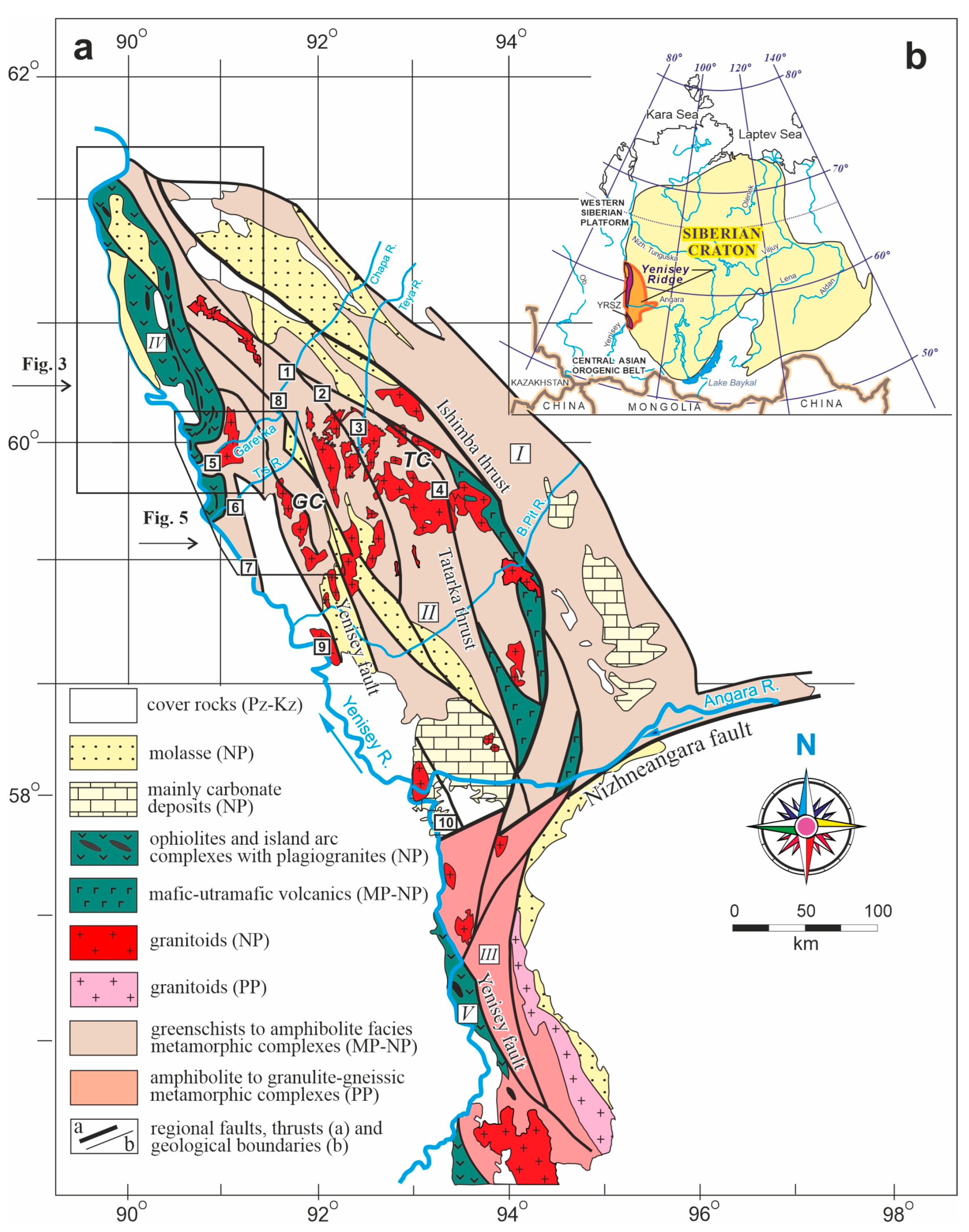
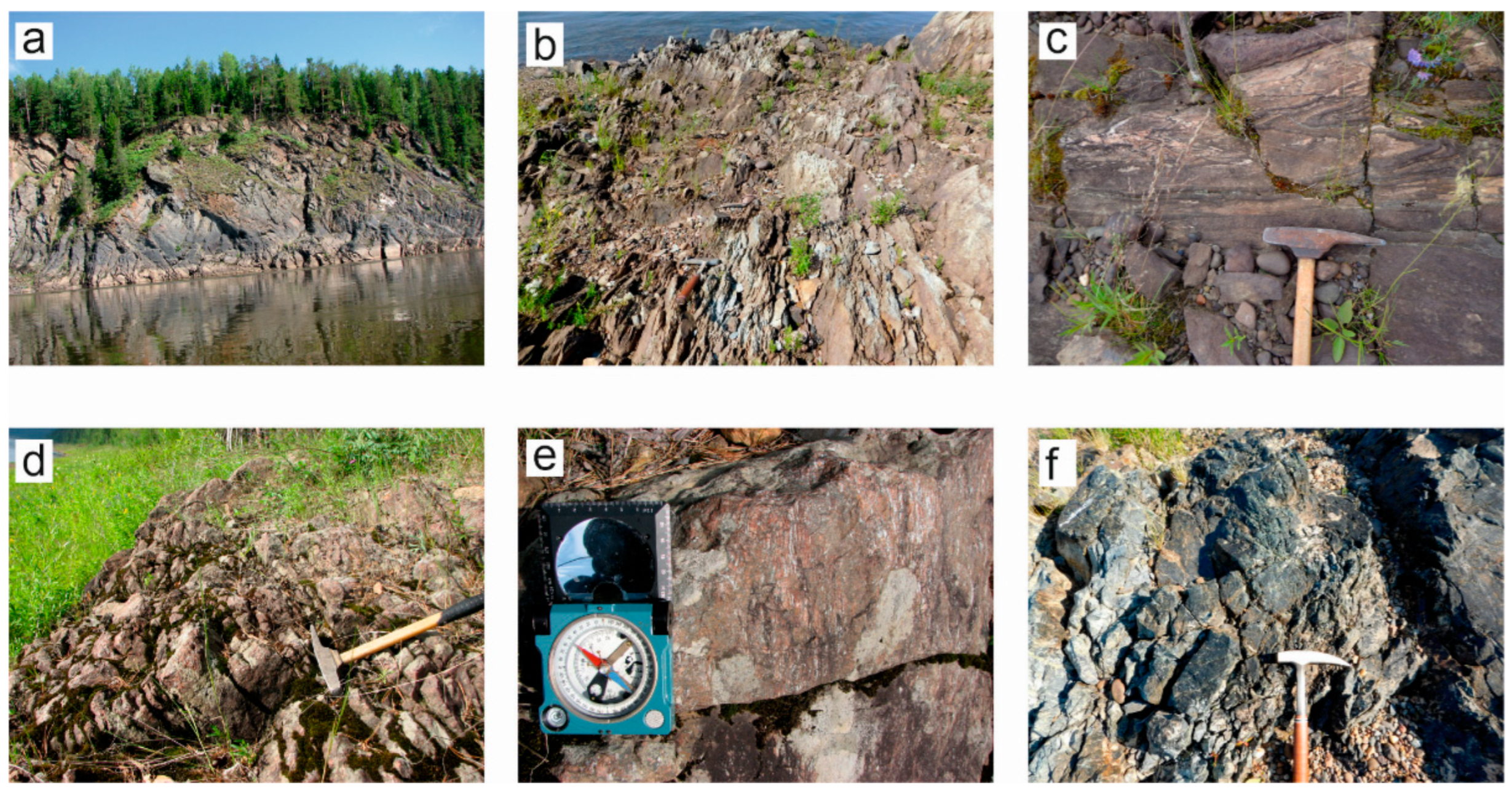
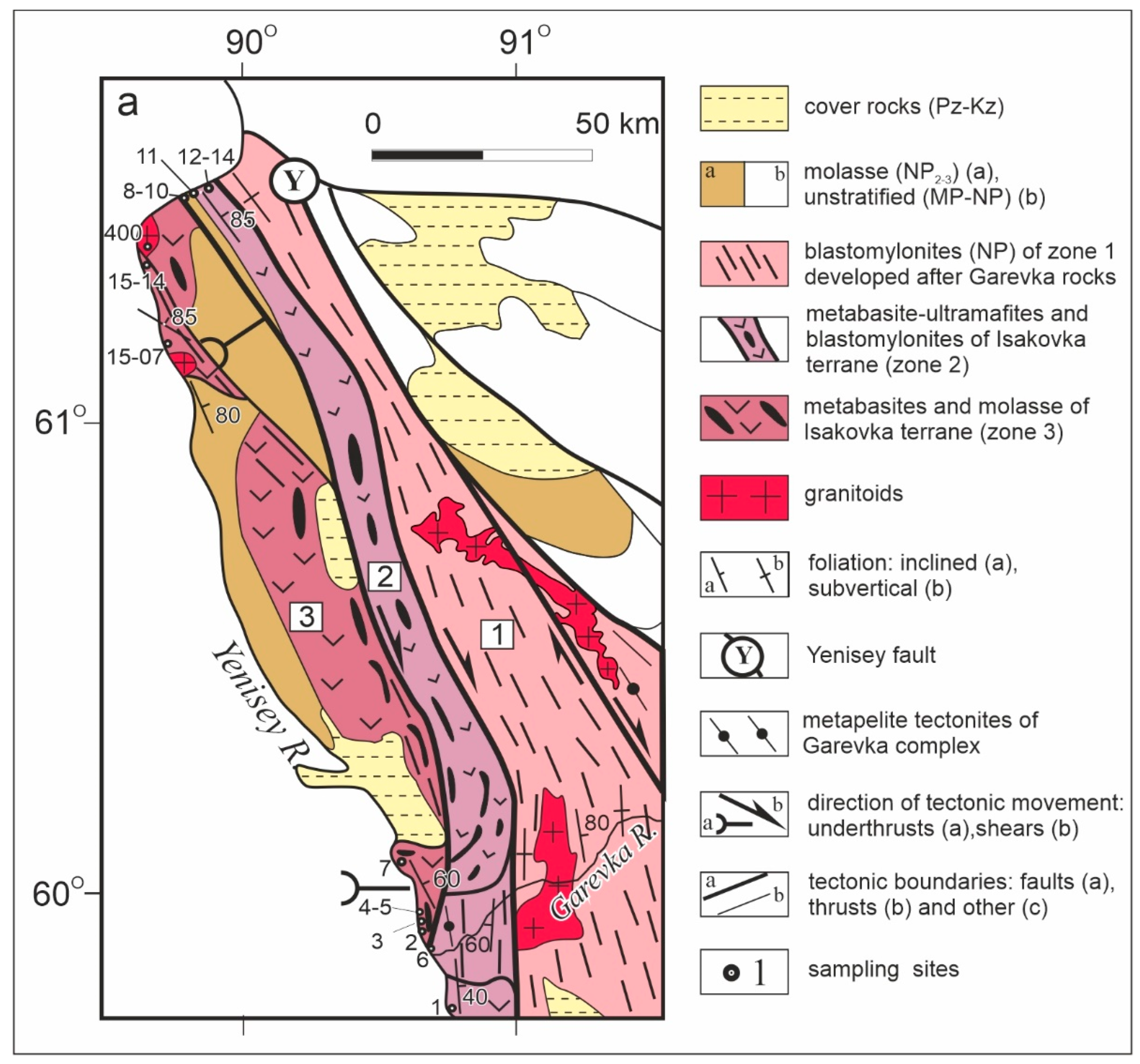


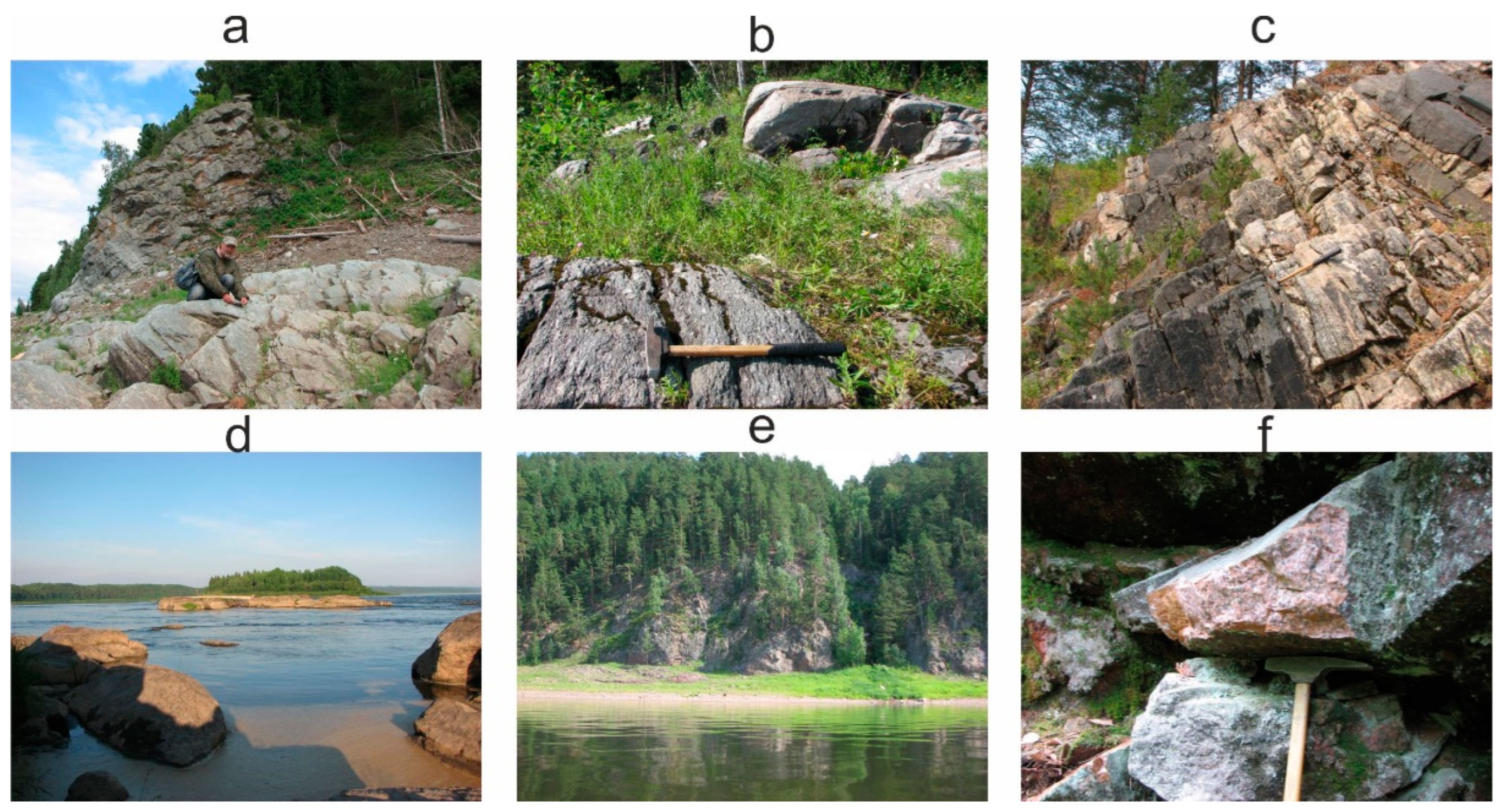
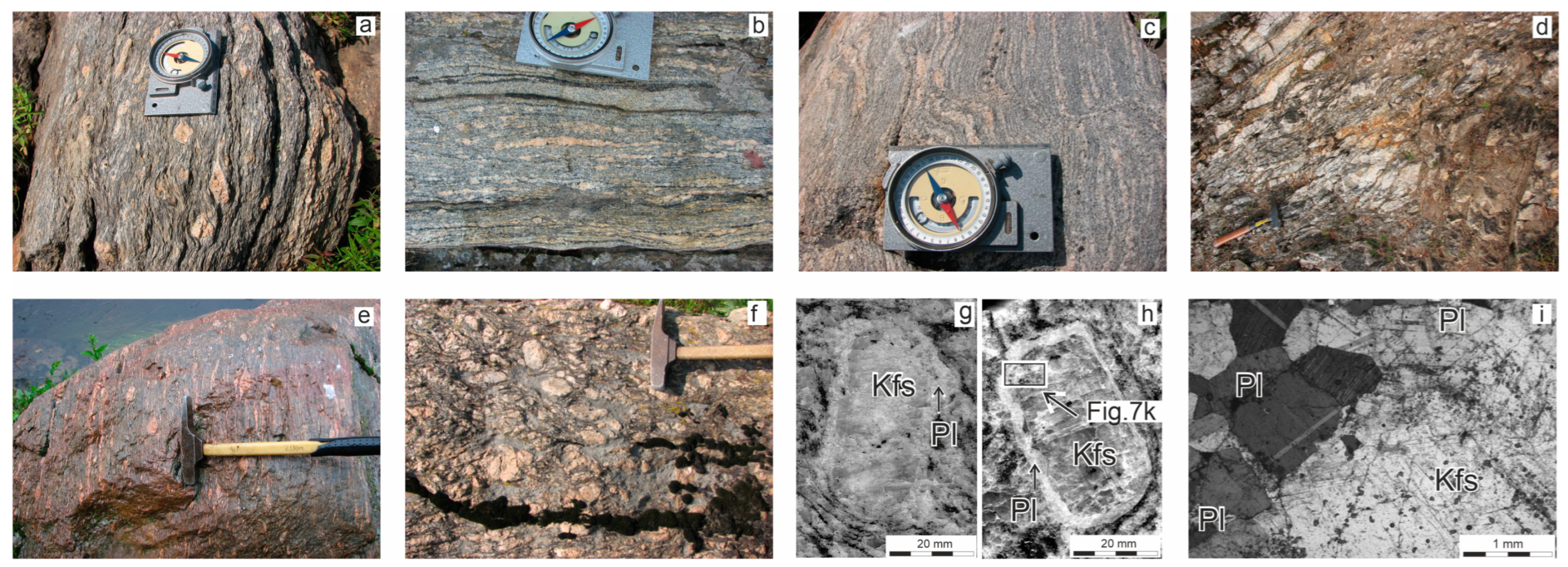

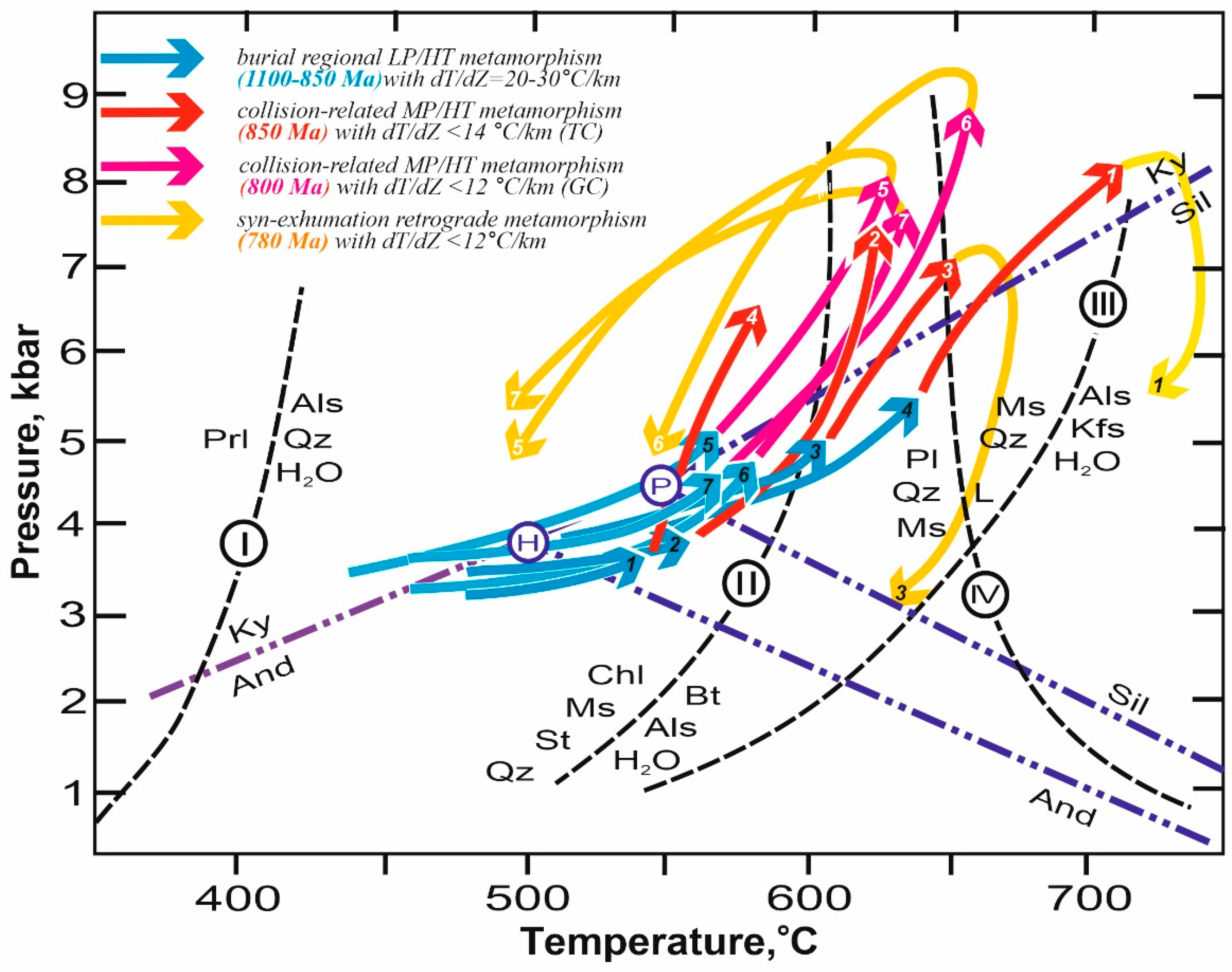
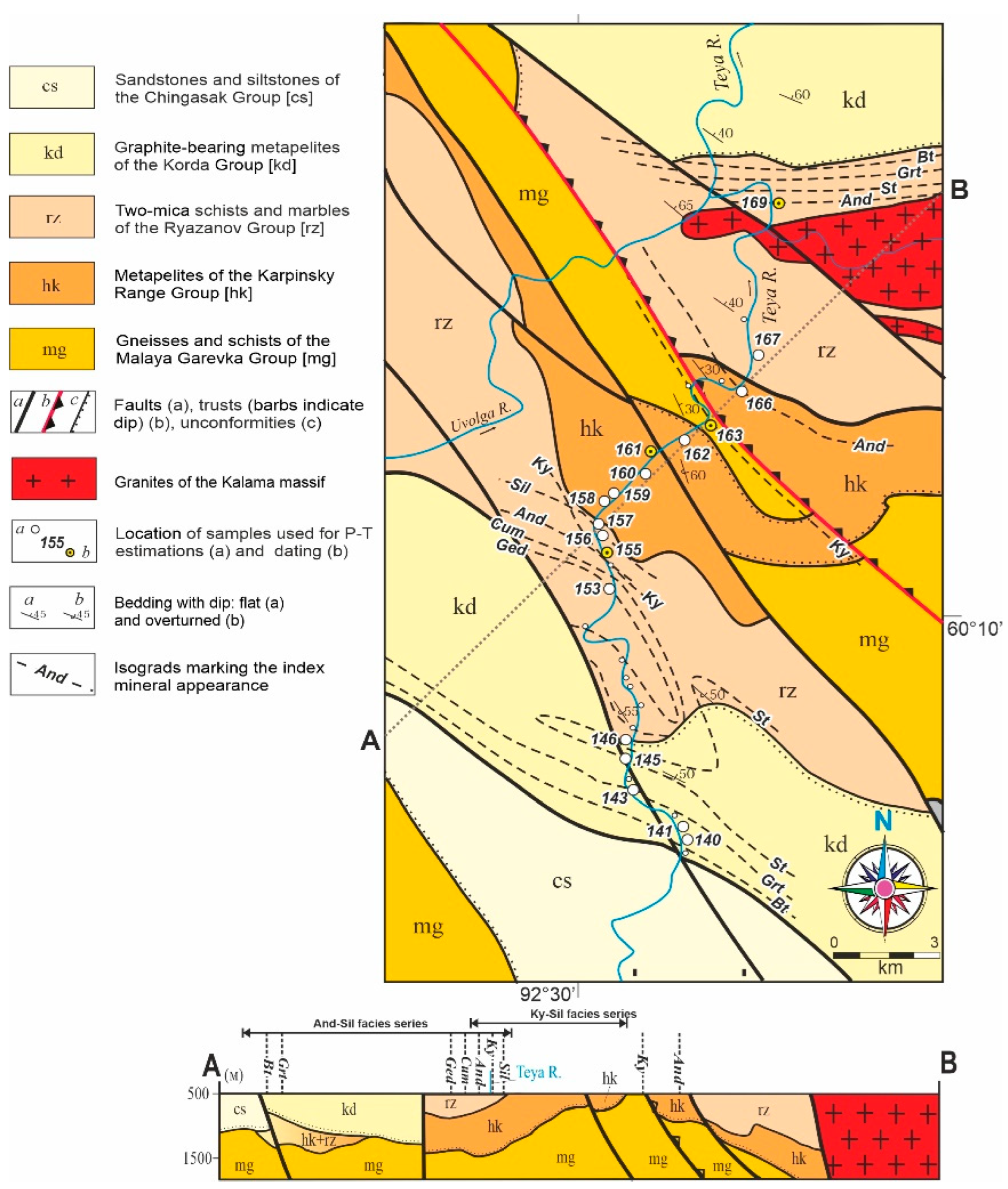
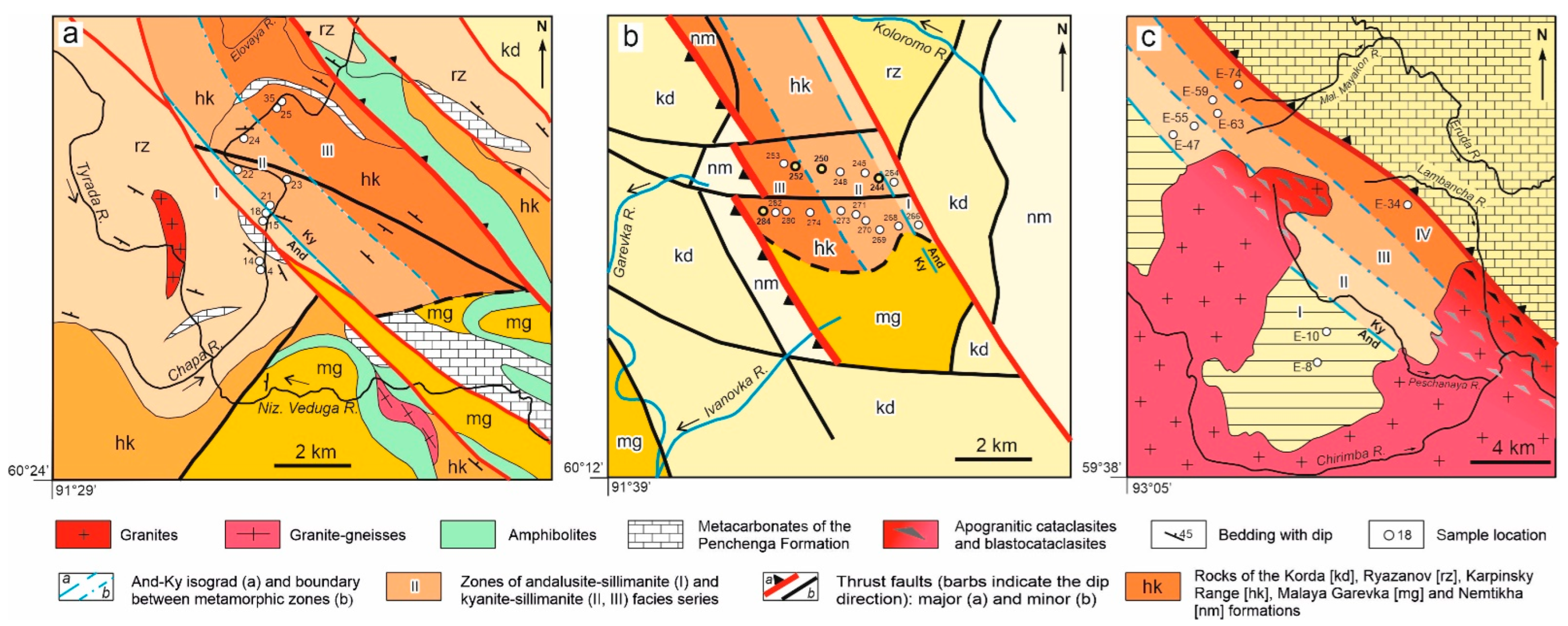

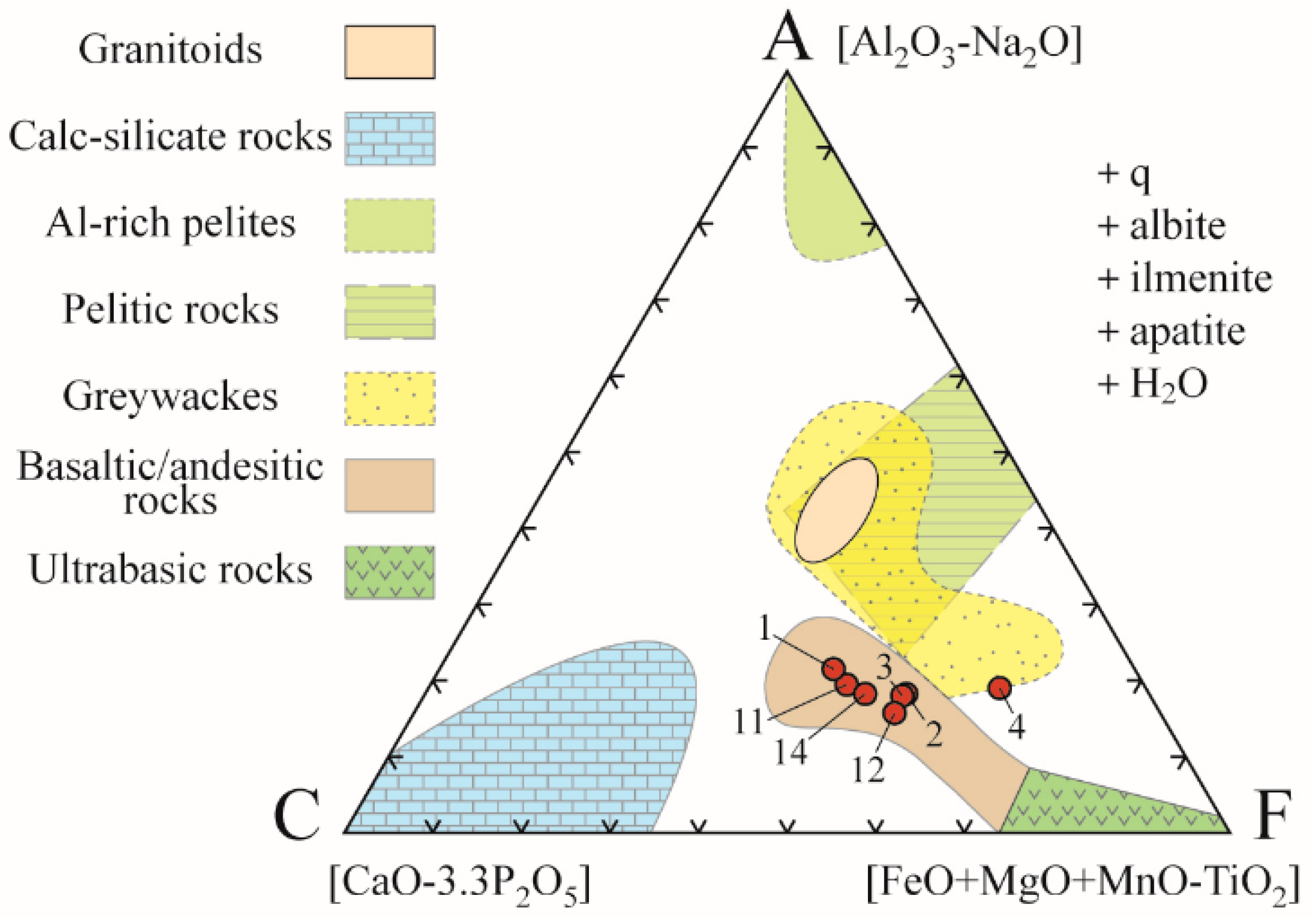
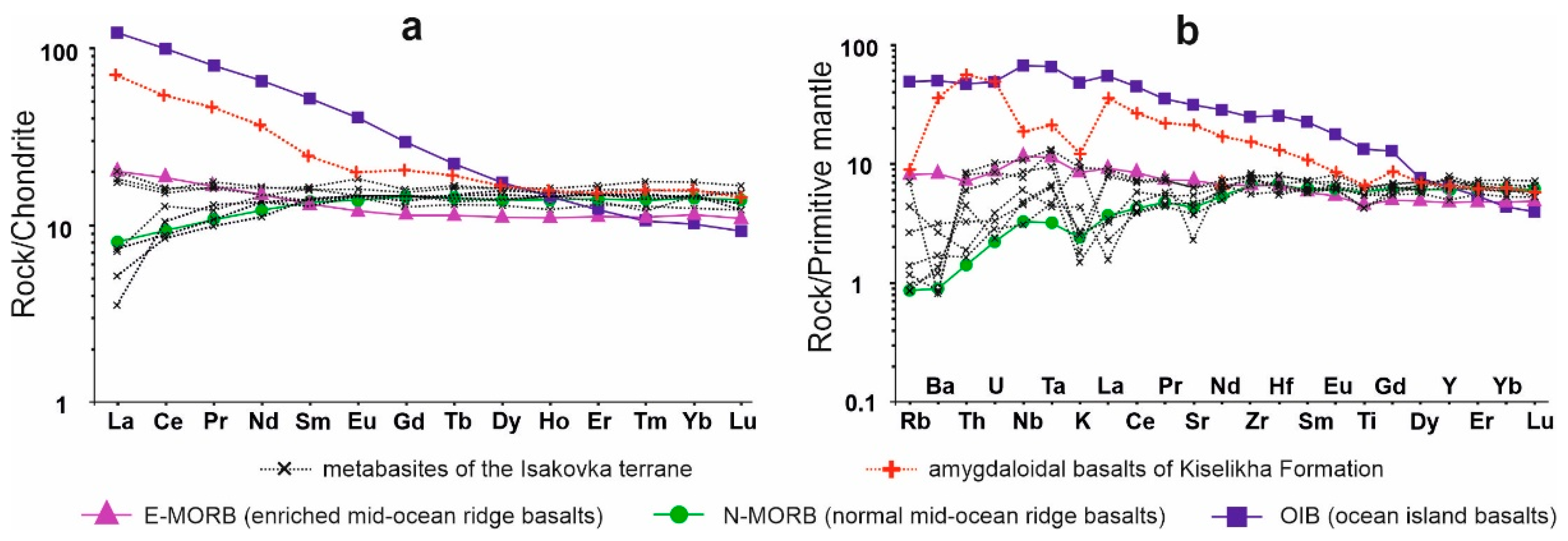
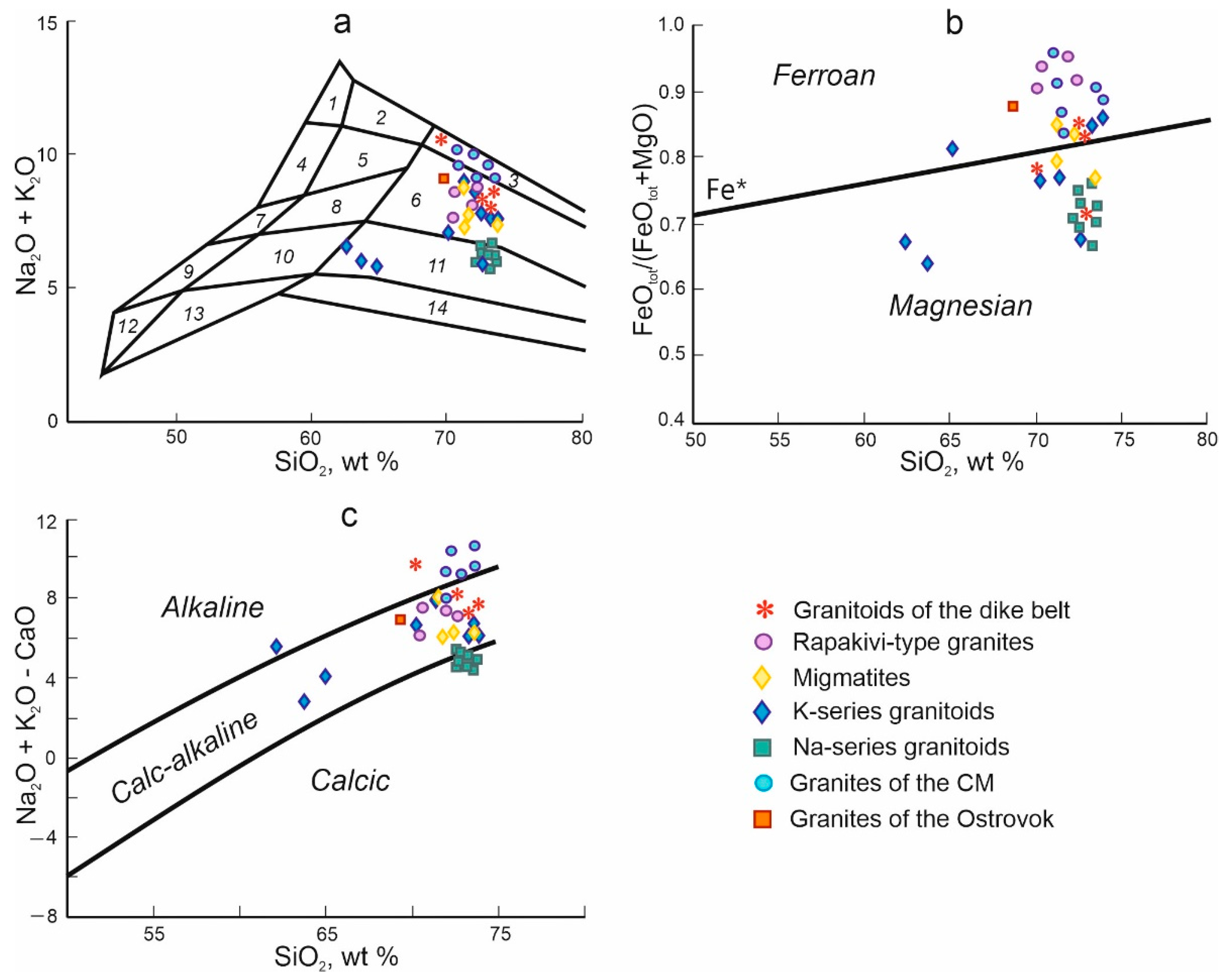

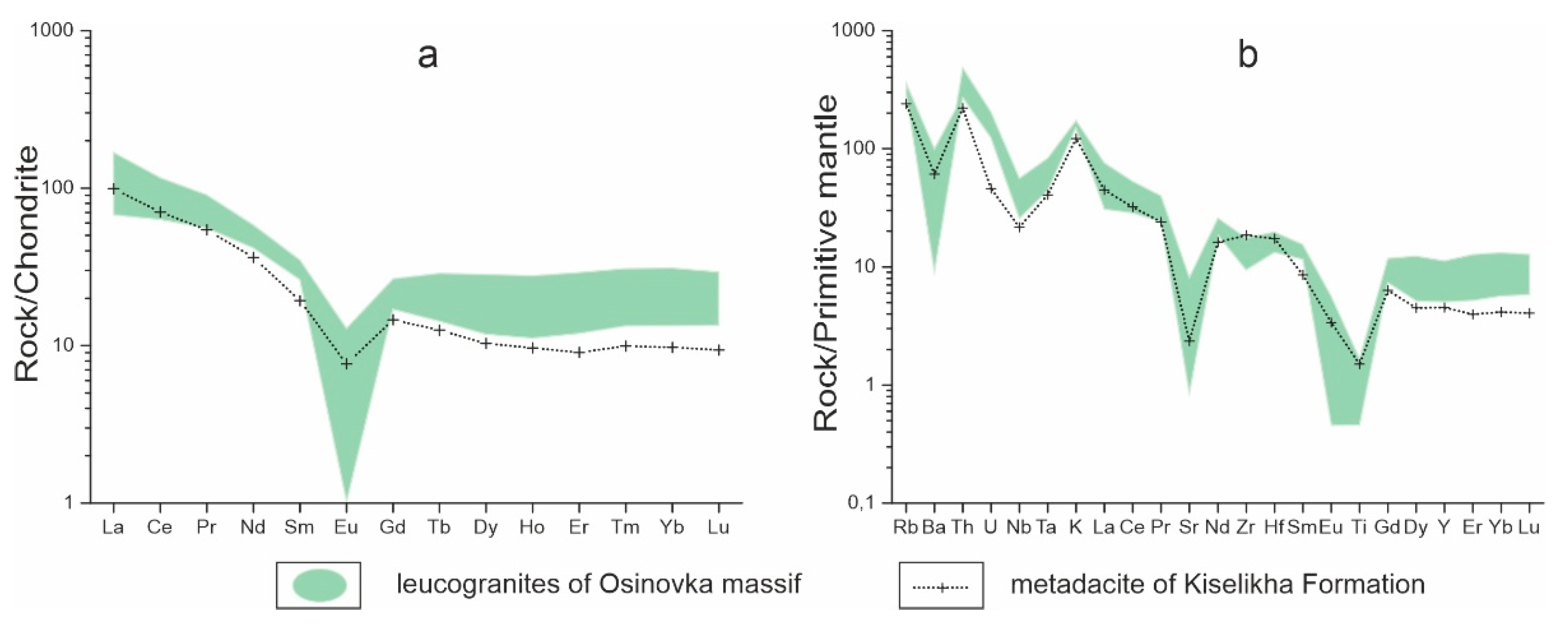
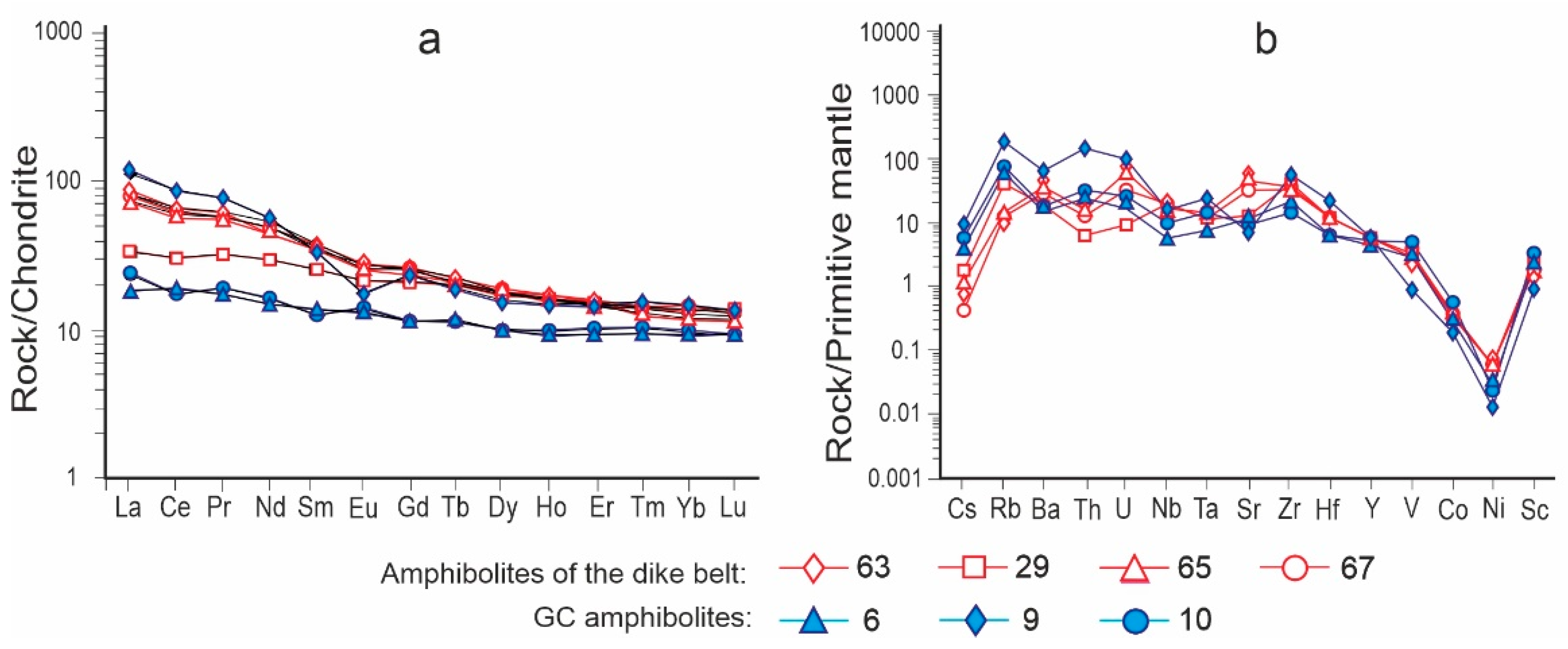

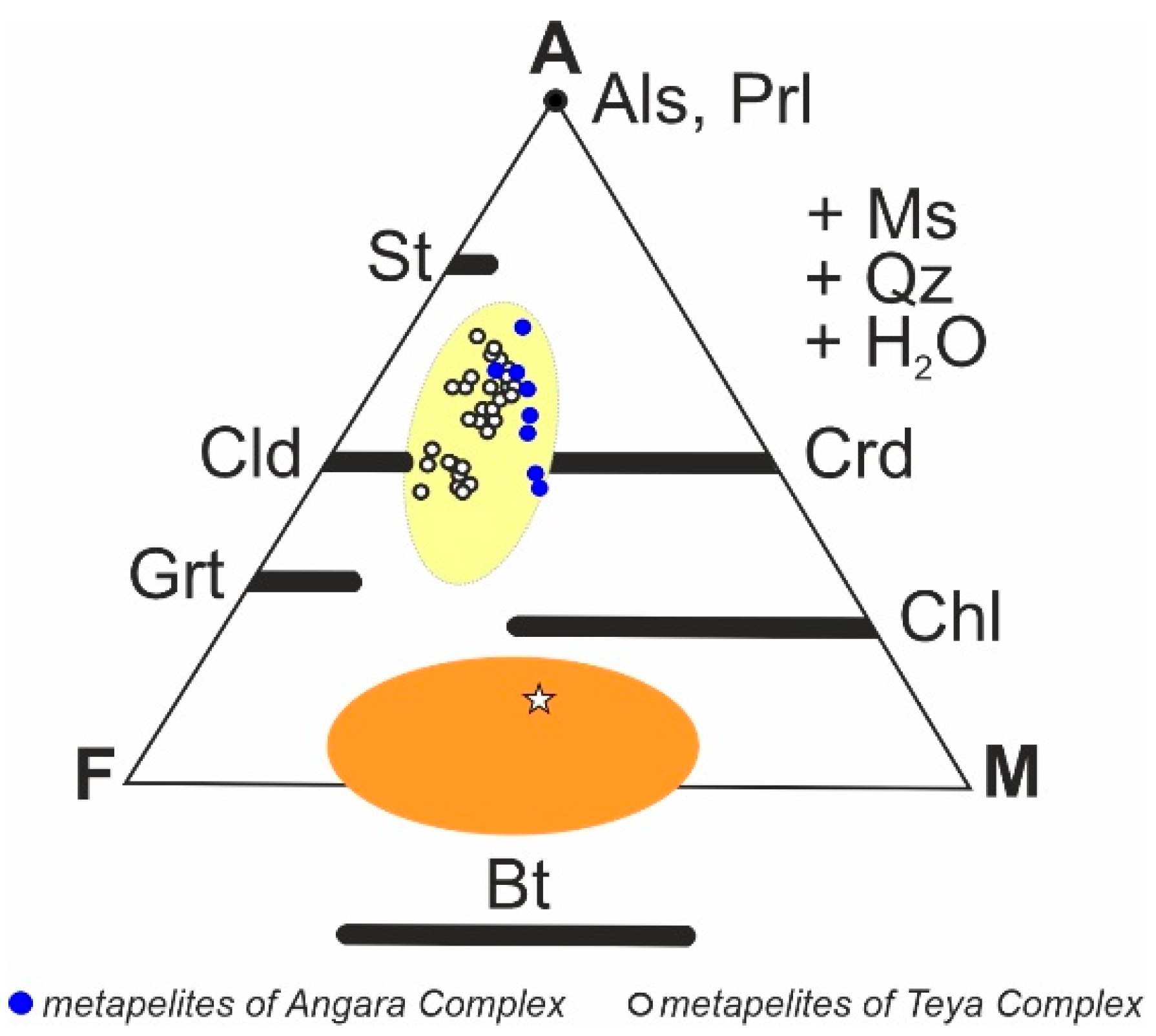
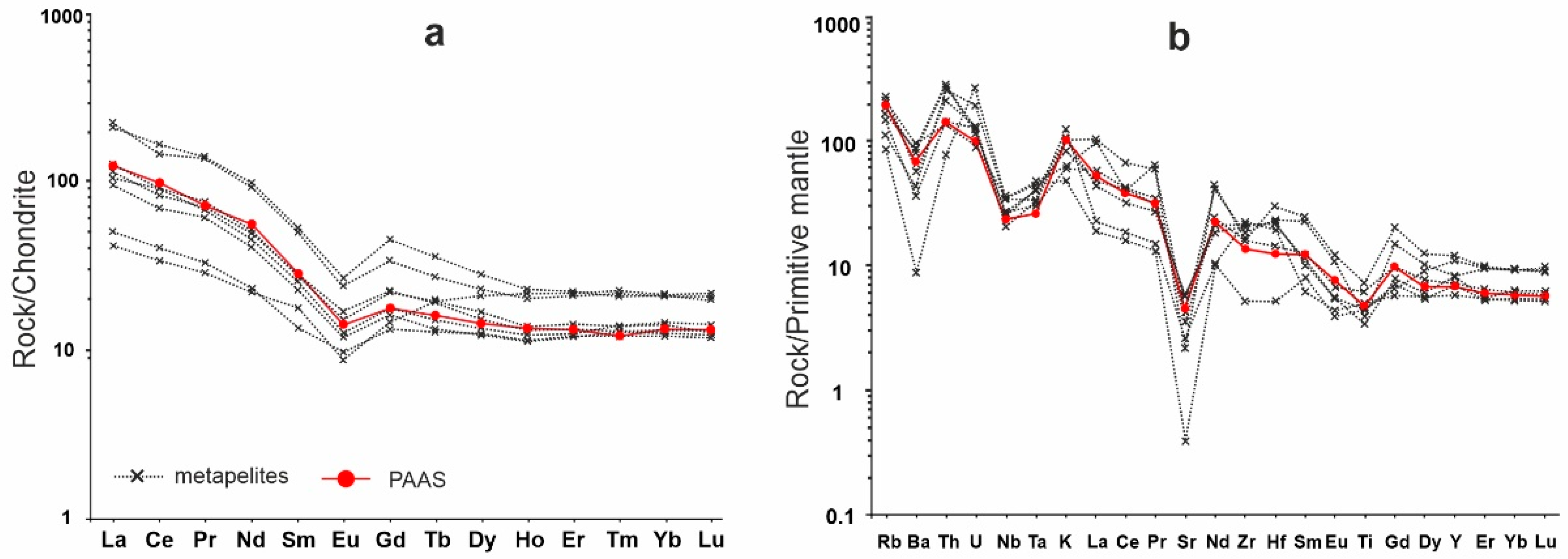

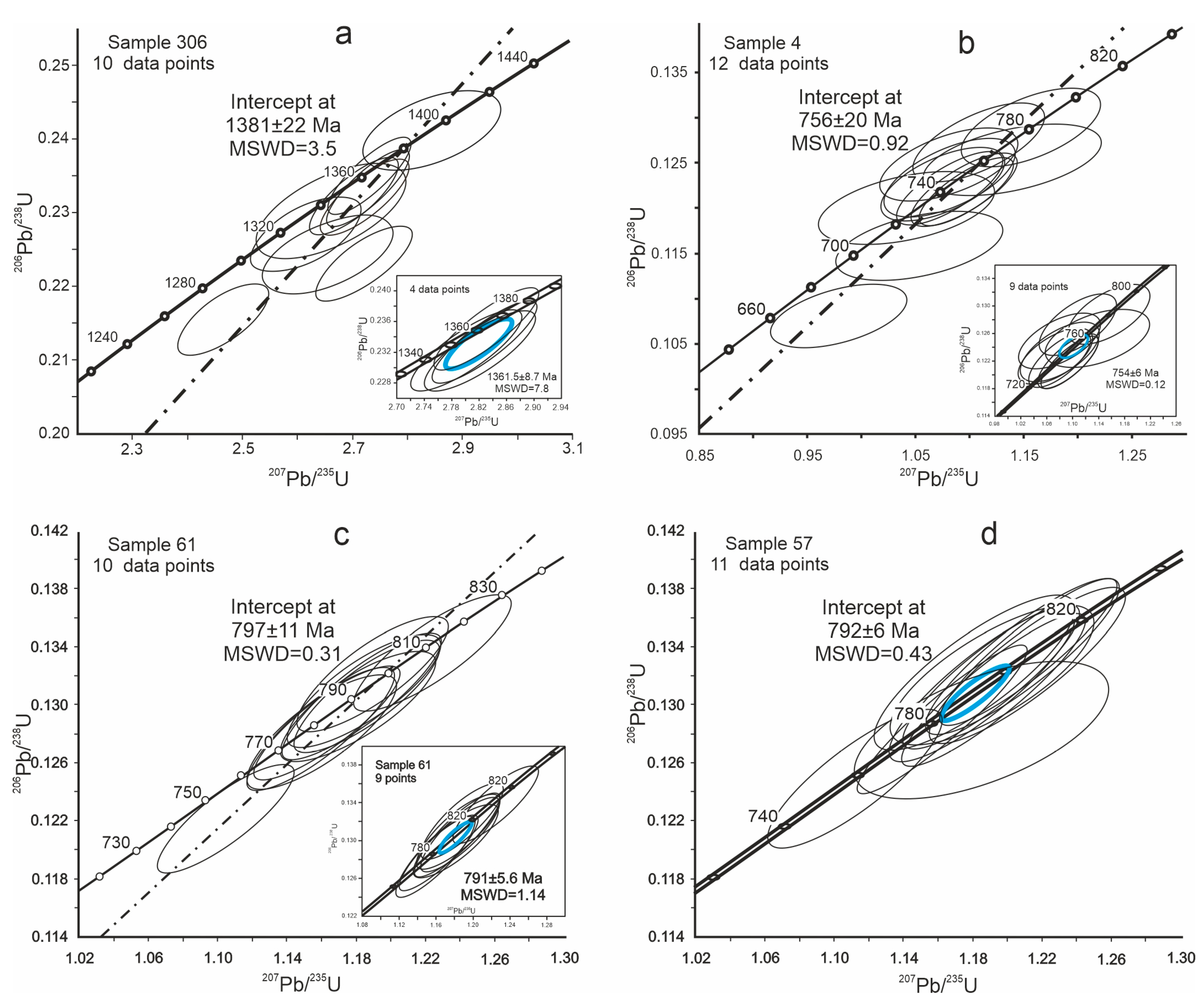


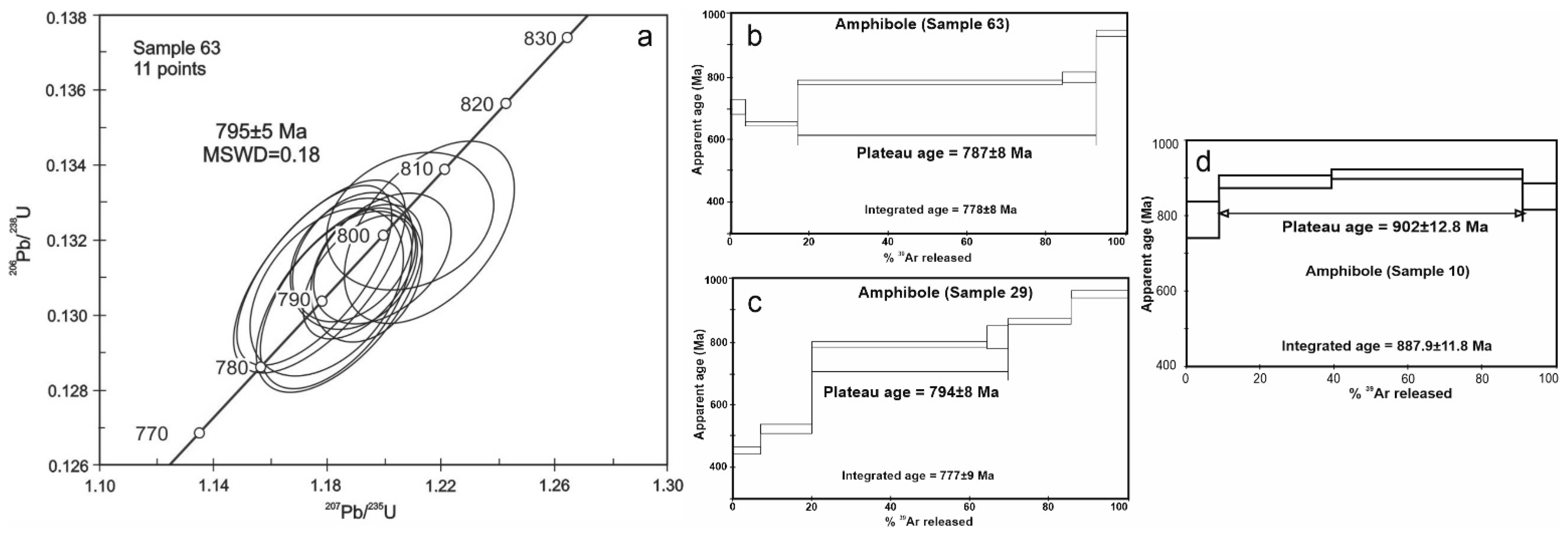
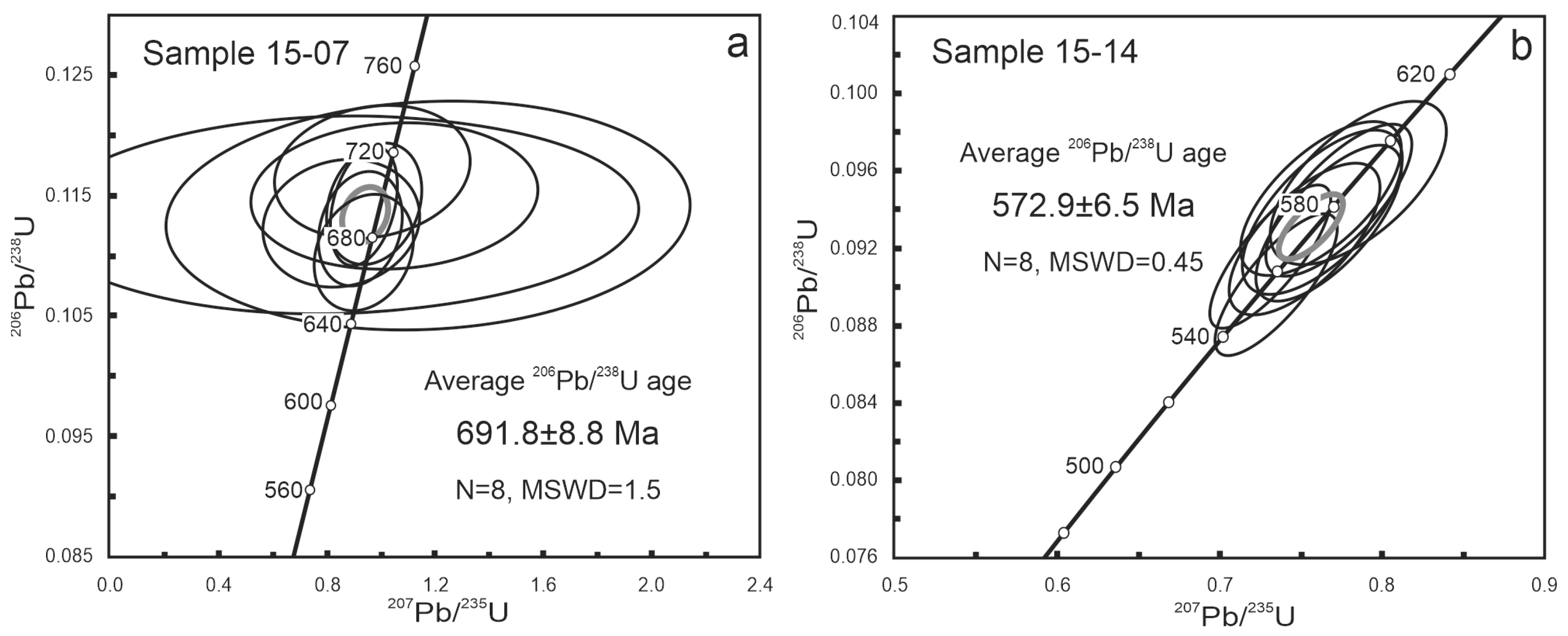
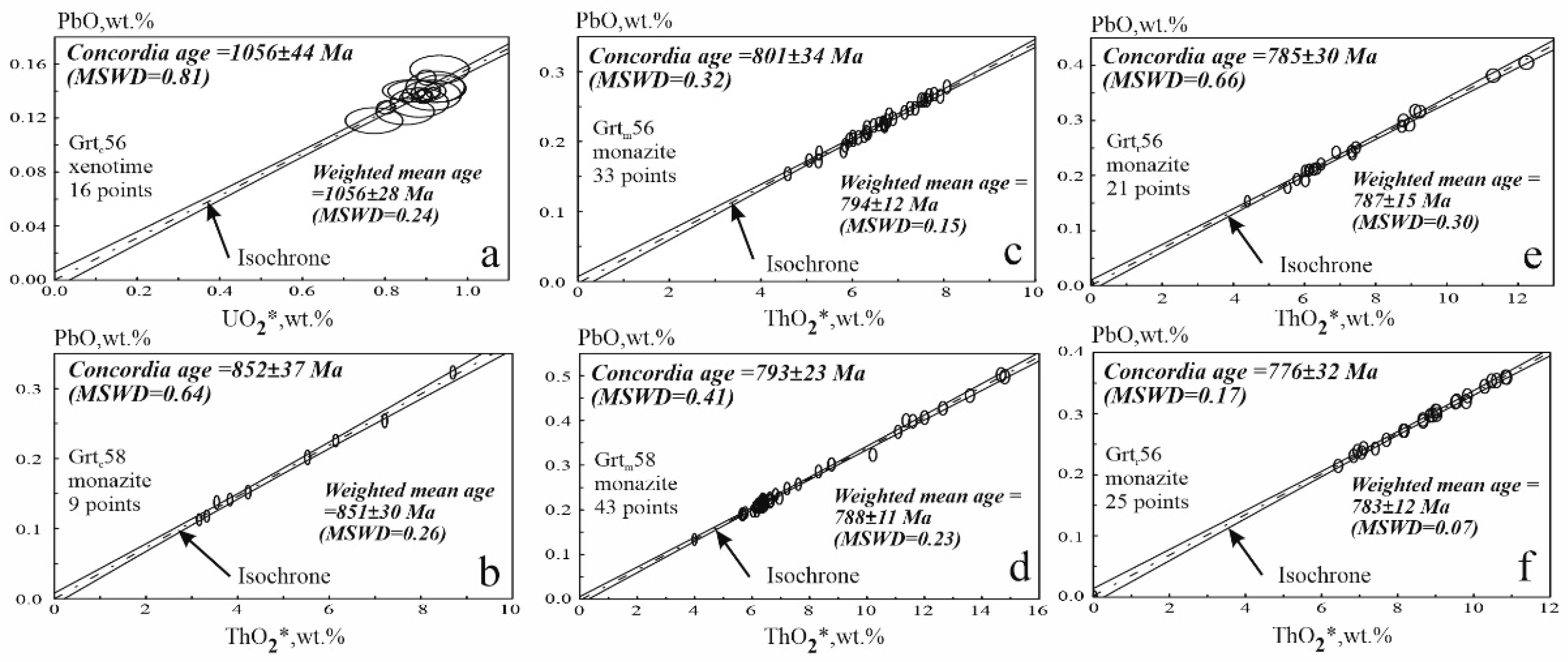
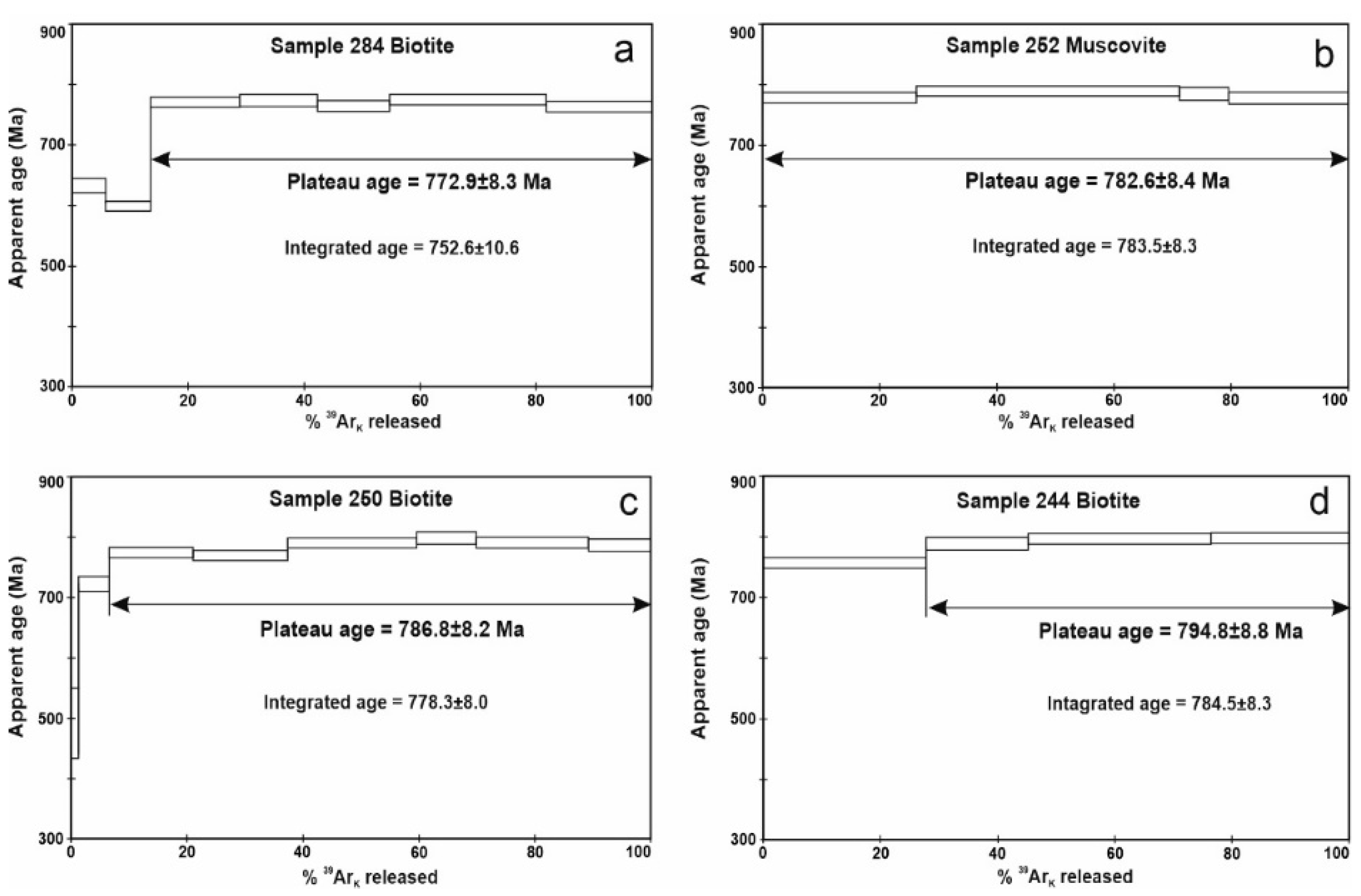
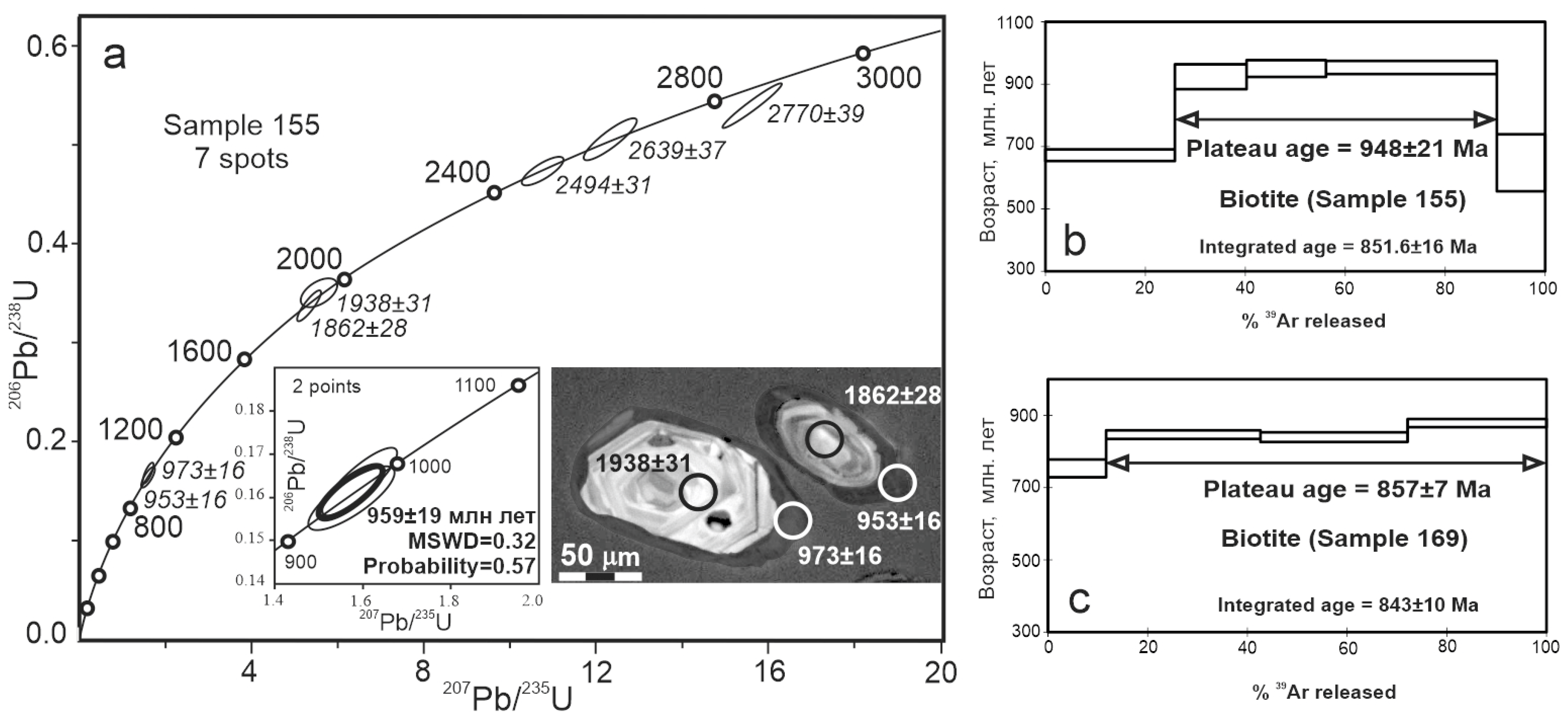
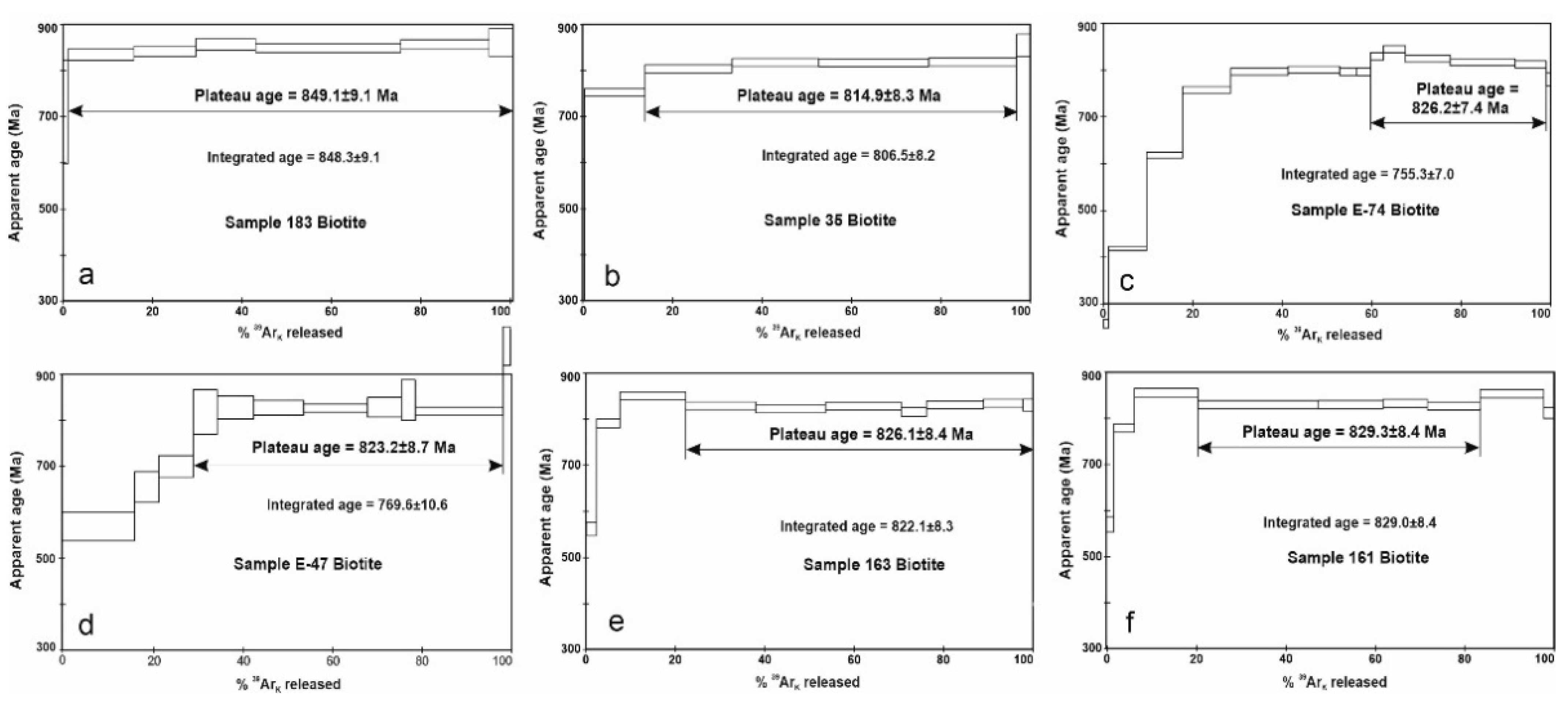


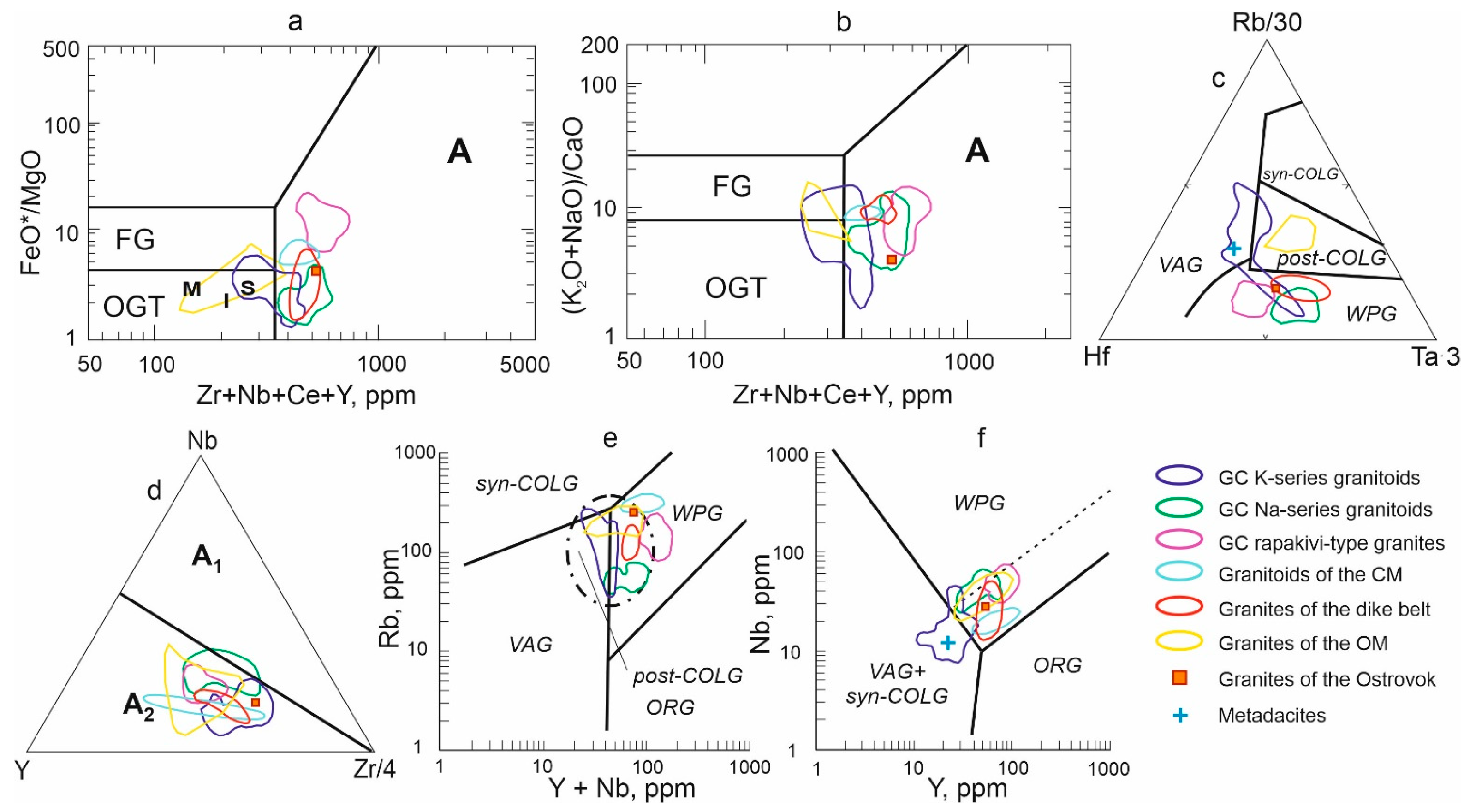

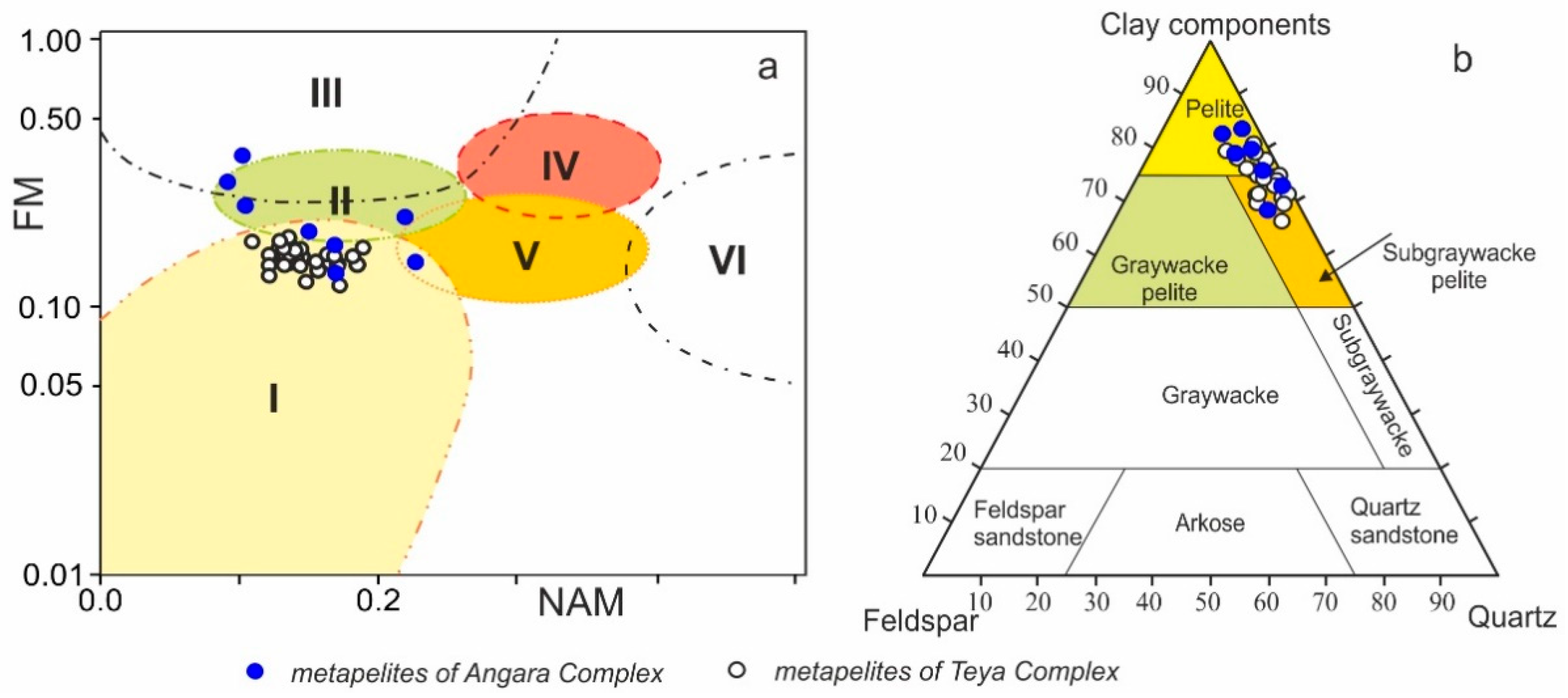

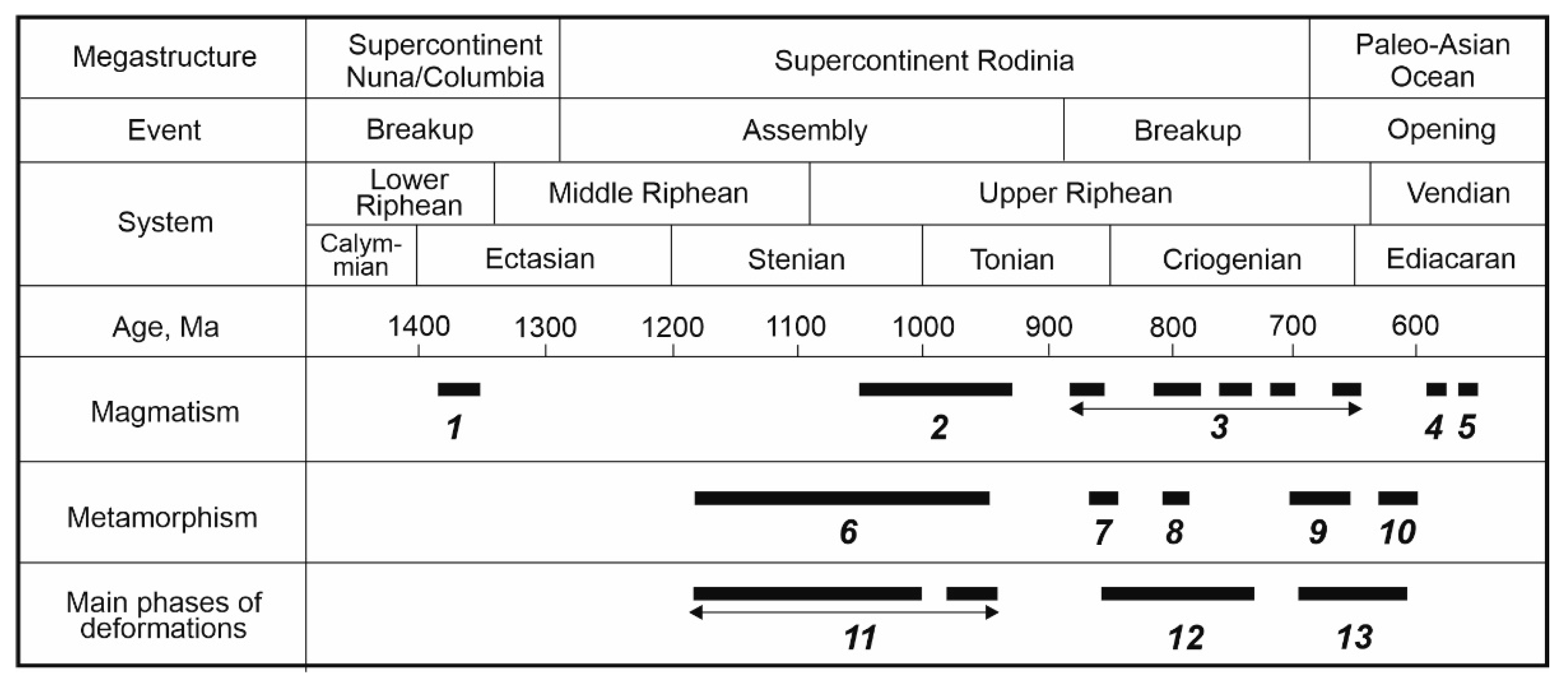
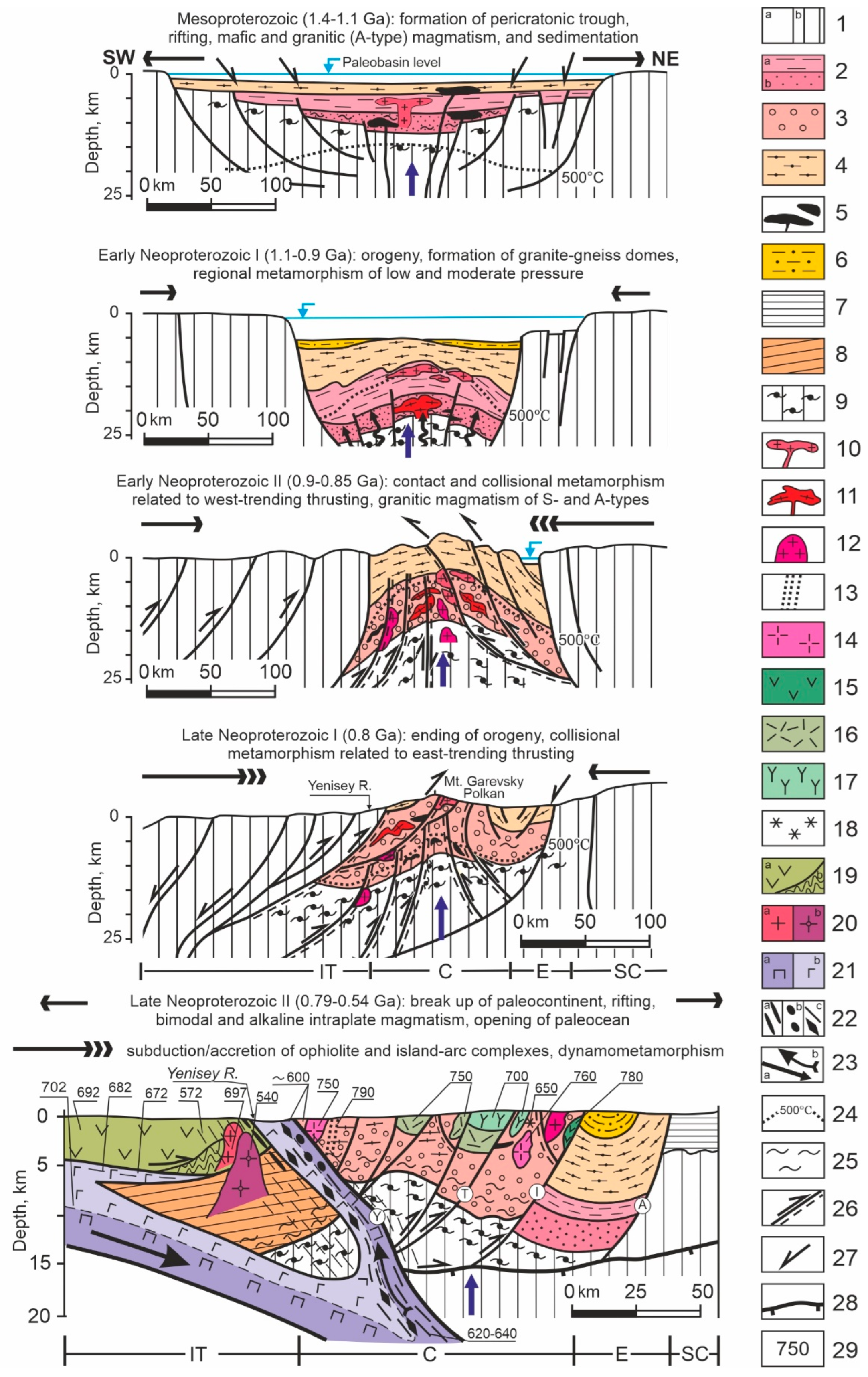
Publisher’s Note: MDPI stays neutral with regard to jurisdictional claims in published maps and institutional affiliations. |
© 2022 by the author. Licensee MDPI, Basel, Switzerland. This article is an open access article distributed under the terms and conditions of the Creative Commons Attribution (CC BY) license (https://creativecommons.org/licenses/by/4.0/).
Share and Cite
Likhanov, I.I. Provenance, Age, and Tectonic Settings of Rock Complexes (Transangarian Yenisey Ridge, East Siberia): Geochemical and Geochronological Evidence. Geosciences 2022, 12, 402. https://doi.org/10.3390/geosciences12110402
Likhanov II. Provenance, Age, and Tectonic Settings of Rock Complexes (Transangarian Yenisey Ridge, East Siberia): Geochemical and Geochronological Evidence. Geosciences. 2022; 12(11):402. https://doi.org/10.3390/geosciences12110402
Chicago/Turabian StyleLikhanov, Igor I. 2022. "Provenance, Age, and Tectonic Settings of Rock Complexes (Transangarian Yenisey Ridge, East Siberia): Geochemical and Geochronological Evidence" Geosciences 12, no. 11: 402. https://doi.org/10.3390/geosciences12110402
APA StyleLikhanov, I. I. (2022). Provenance, Age, and Tectonic Settings of Rock Complexes (Transangarian Yenisey Ridge, East Siberia): Geochemical and Geochronological Evidence. Geosciences, 12(11), 402. https://doi.org/10.3390/geosciences12110402






